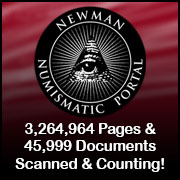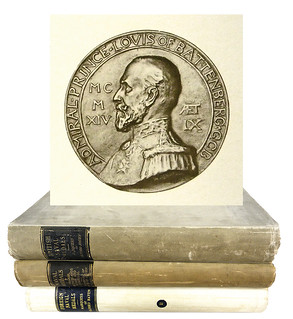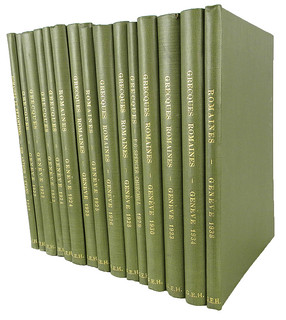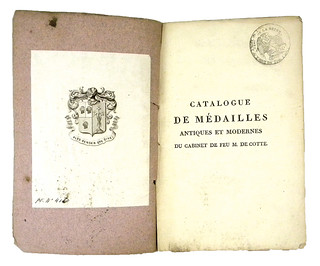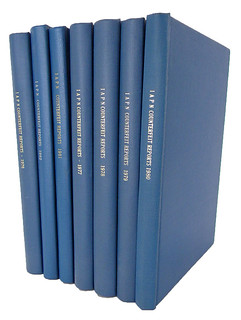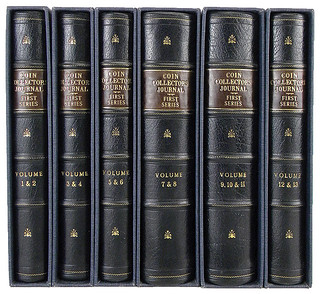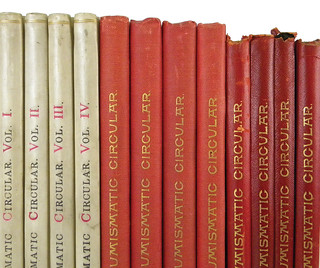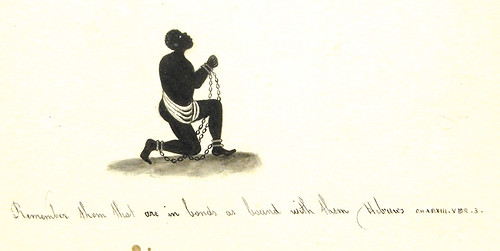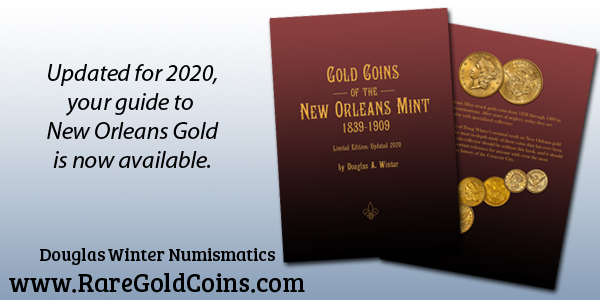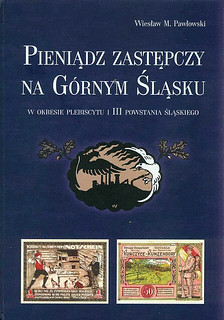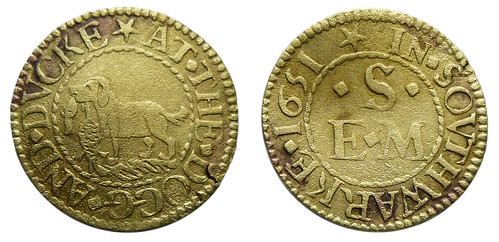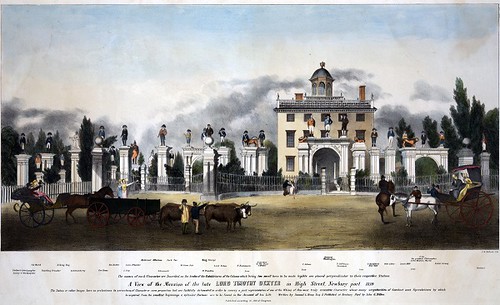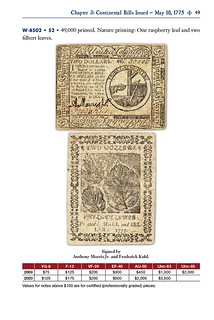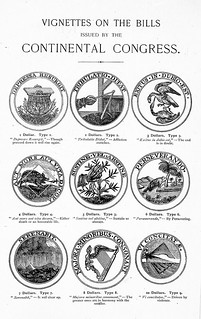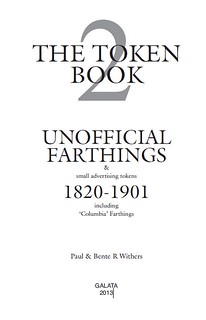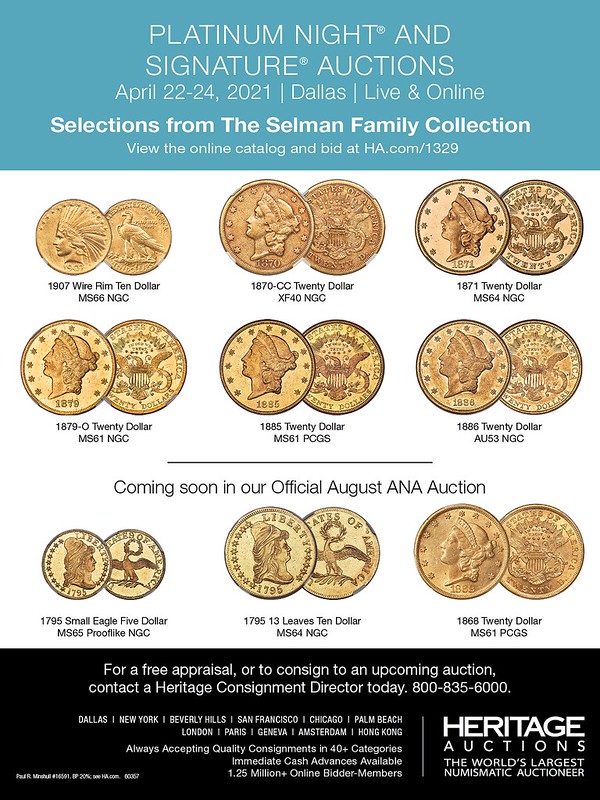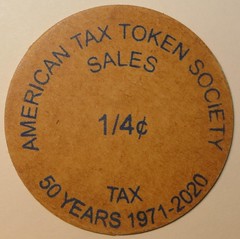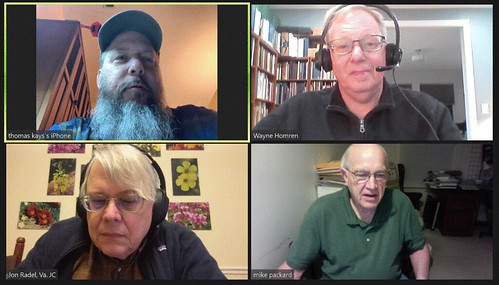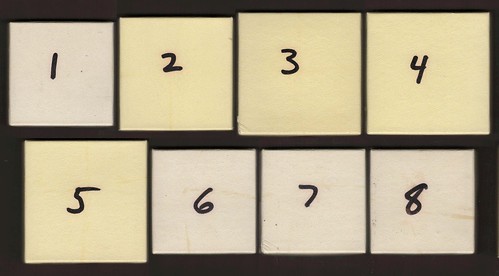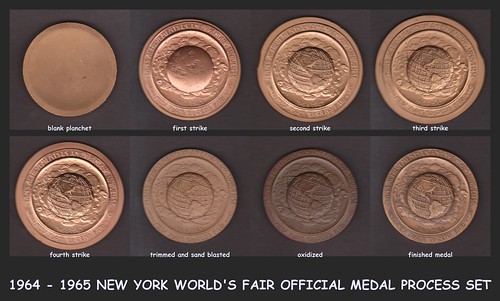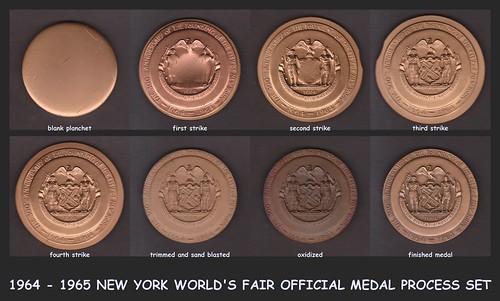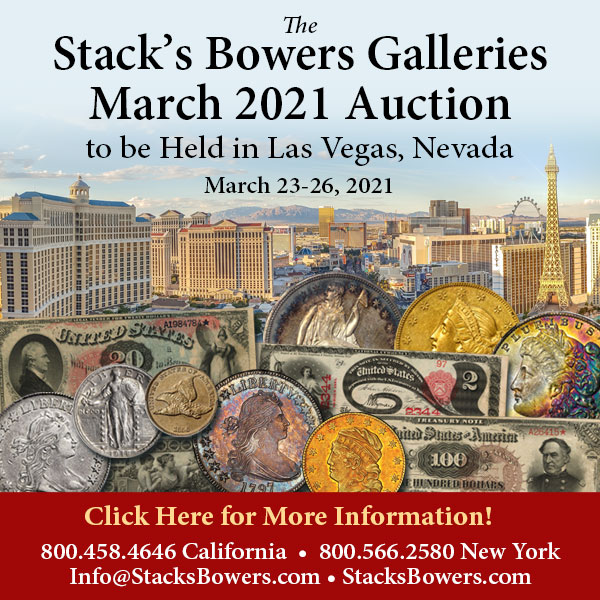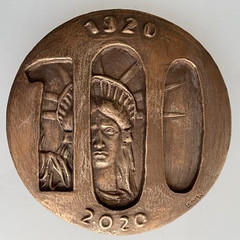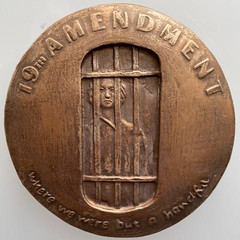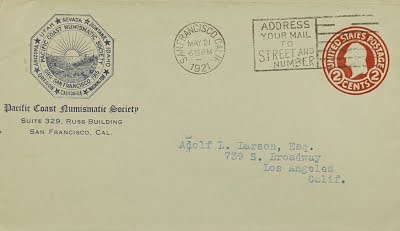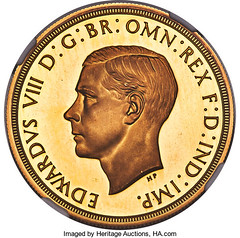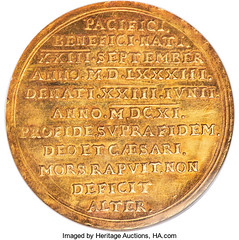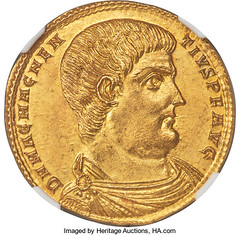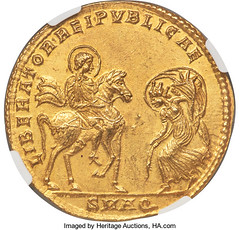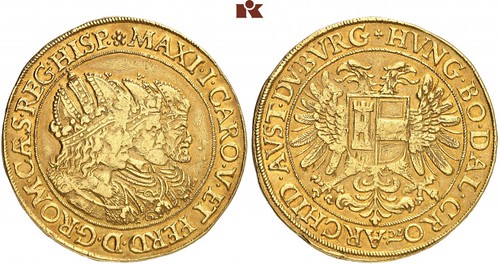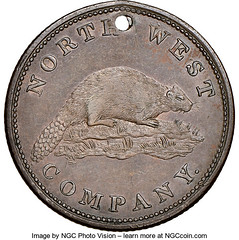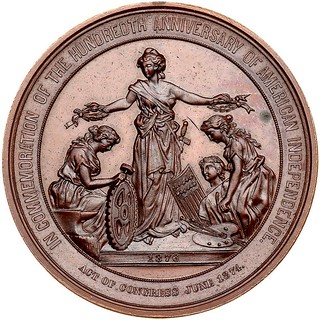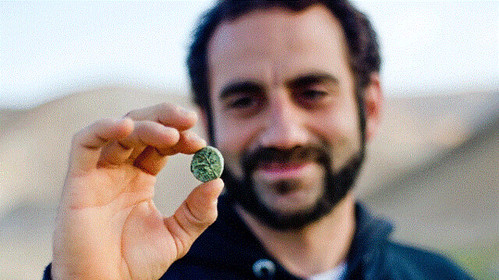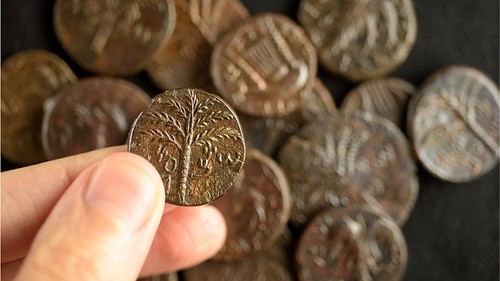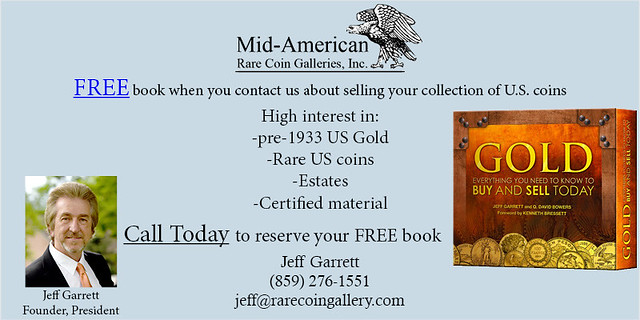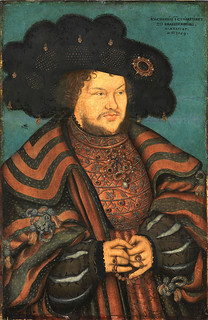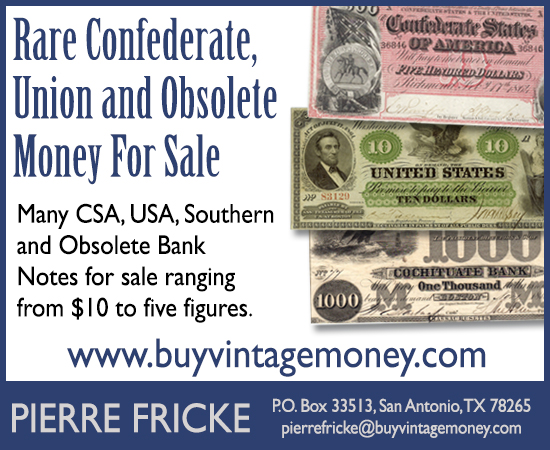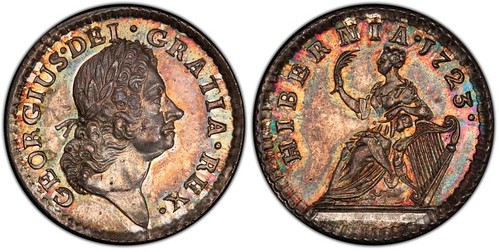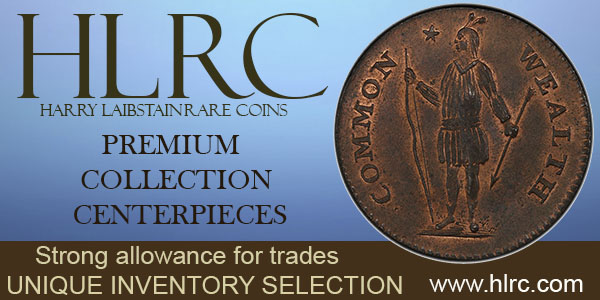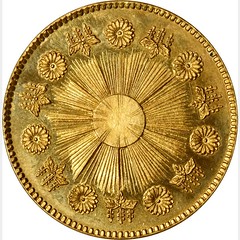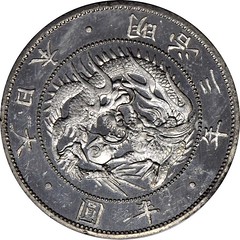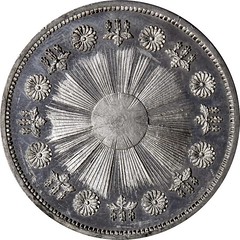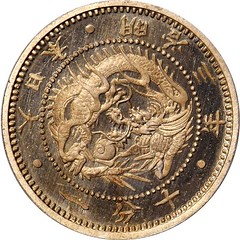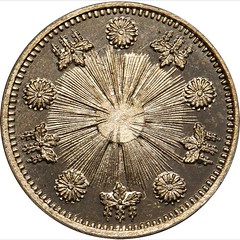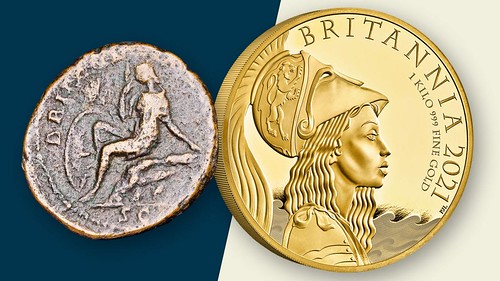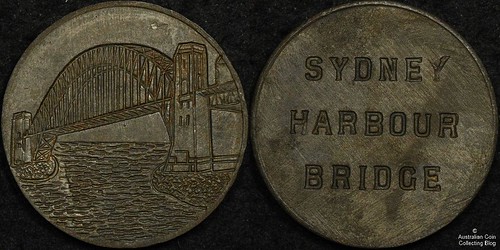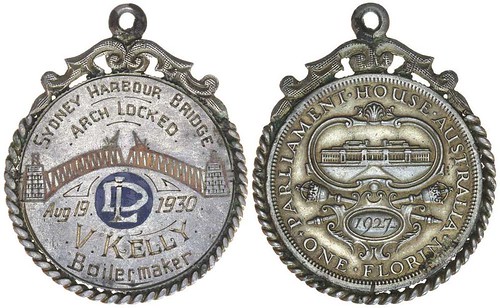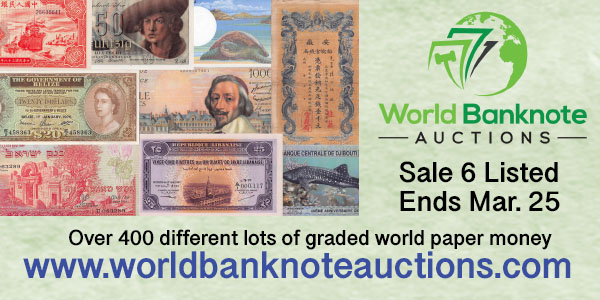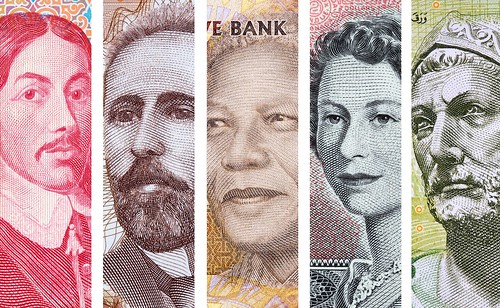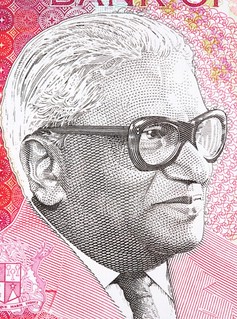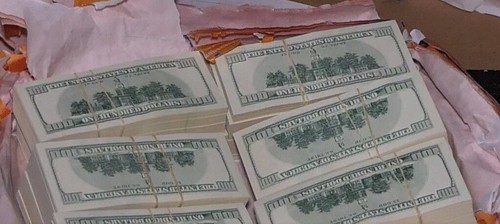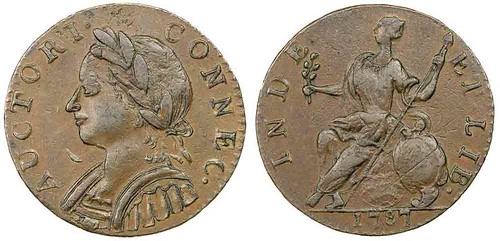
Visit our NBS Sponsors


About UsThe Numismatic Bibliomania Society is a non-profit association devoted to the study and enjoyment of numismatic literature. For more information please see our web site at coinbooks.org SubscriptionsThose wishing to become new E-Sylum subscribers (or wishing to Unsubscribe) can go to the following web page link MembershipThere is a membership application available on the web site Membership Application To join, print the application and return it with your check to the address printed on the application. Print/Digital membership is $40 to addresses in the U.S., and $60 elsewhere. A digital-only membership is available for $25. For those without web access, write to: Charles Heck, Treasurer AsylumFor Asylum mailing address changes and other membership questions, contact Chuck at this email address: treasurer@coinbooks.org SubmissionsTo submit items for publication in The E-Sylum, write to the Editor at this address: whomren@gmail.com > BUY THE BOOK BEFORE THE COINSale Calendar
|
- WAYNE'S WORDS: THE E-SYLUM MARCH 21, 2021
- KOLBE & FANNING MARGOLIS LIBRARY RESULTS
- NEW BOOK: UPPER SILESIA EMERGENCY MONEY
- NEW BOOK: THAMES MUDLARKING
- NEW BOOK: EMPIRE OF SILVER
- QDB: MY JOURNEY IN CONTINENTAL CURRENCY
- ANA'S MANLEY NUMISMATIC LIBRARY REOPENS
- VIDEO: OLD GUYS TALKING ABOUT EARLY COPPER
- PCGS NUMISMATIC WRITER OF THE YEAR AWARDS
- CONTINENTAL DOLLAR OFFERED FOR SALE IN 1785
- 1777 GERMAN ILLUSTRATIONS OF COLONIAL PAPER
- MORE ON COLUMBIA FARTHINGS
- NOTES FROM E-SYLUM READERS: MARCH 21, 2021
- NEW YORK WORLD'S FAIR MEDAL PROCESS SET
- AMSA’S WOMEN’S SUFFRAGE MEDAL COMPETITION
- VOCABULARY TERM: DATES AND DATING
- ADOLF LARSON (1878-1967)
- ALAN STAHL EARNS GILES CONSTABLE AWARD
- NUMISMATIC NEWS INTERVIEWS HOWARD DANIEL III
- HERITAGE OFFERS PARAMOUNT COLLECTION
- NUMISMATIC NUGGETS: MARCH 21, 2021
- COINS FOUND ALONGSIDE DEAD SEA SCROLL
- MUGHAL-ERA GOLD COIN FIND IN INDIA
- NEW COIN: THE FIRST BRANDENBURG TALER
- THE SILVER 1723 WOOD'S HIBERNIA FARTHINGS
- 1870 JAPAN WYON PATTERN SET OFFERED
- A RARE 1860 CAMBODIA PIASTRE
- ROYAL MINT ISSUES NEW BRITANNIA
- SYDNEY HARBOUR BRIDGE TOKENS AND MEDALS
- YELLEN PROVIDES PAPER MONEY SIGNATURE
- THE FACES ON WORLD BANKNOTES
- BANKNOTE OF THE YEAR 2020 NOMINEES
- COUNTERFEIT CURRENCY SEIZED IN BULGARIA
- LOOSE CHANGE: MARCH 21, 2021
- YOUNG FOLKS DISCOVERING ANTIQUES
- FEATURED WEB SITE: EVERYCOUNTRY
Click here to read the thin version on the web
Click here to subscribe
Click here to access the complete archive
To comment or submit articles, reply to whomren@gmail.com
Content presented in The E-Sylum is not necessarily researched or independently fact-checked, and views expressed do not necessarily represent those of the Numismatic Bibliomania Society.
WAYNE'S WORDS: THE E-SYLUM MARCH 21, 2021
 New subscribers this week include:
Larry McCumber.
Welcome aboard! We now have 6,613 subscribers.
New subscribers this week include:
Larry McCumber.
Welcome aboard! We now have 6,613 subscribers.
Thank you for reading The E-Sylum. If you enjoy it, please send me the email addresses of friends you think may enjoy it as well and I'll send them a subscription. Contact me at whomren@gmail.com anytime regarding your subscription, or questions, comments or suggestions about our content.
This week we open with results of the Richard Margolis numismatic library sale, four new books, the reopening of the ANA library, updates from the Newman Numismatic Portal, and more.
Other topics this week include early U.S. copper coins, the Continental dollar, Columbia farthings, World's Fair medals, upcoming auctions, coin finds, the first Brandenburg taler, Yellen's banknote signature, world banknotes, and music to collect coins by.
To learn more about Maltese coins, Thames mudlarking, U.S. coins and paper money in 18th-century German publications, tax tokens, the Women’s Suffrage Medal, the Northwest Company token, silver Wood's Hibernia farthings, Connecticut Coppers, sexy ‘80s dad vibes, read on. Have a great week, everyone!
Wayne Homren
Editor, The E-Sylum
KOLBE & FANNING MARGOLIS LIBRARY RESULTS
Many record prices were set in the recent Kolbe & Fanning sale of the Richard Margolis library. Here are some highlights. -Editor
MARGOLIS LIBRARY BRINGS RECORD PRICES
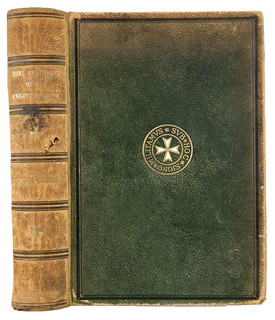 Kolbe & Fanning Numismatic Booksellers sold highlights from the numismatic library of the late Richard Margolis at auction on Saturday, March 6, 2021. The sale attracted considerable attention from all over the world, with well over 250 bidders registering for the 539-lot sale. The sale realized more than twice its pre-sale estimate, with a number of lots bringing astonishing prices amidst heavy bidding. A handful of examples include:
Kolbe & Fanning Numismatic Booksellers sold highlights from the numismatic library of the late Richard Margolis at auction on Saturday, March 6, 2021. The sale attracted considerable attention from all over the world, with well over 250 bidders registering for the 539-lot sale. The sale realized more than twice its pre-sale estimate, with a number of lots bringing astonishing prices amidst heavy bidding. A handful of examples include:
Lot 236: an original copy of Schembri on Maltese coins, brought $4800 on a $300 estimate
Lot 255: a complete set of Milford Haven on the Medallic History of Navies, estimated at $2500, realized $6600
Lot 322: a partial set of Ars Classica sales in matching bindings, sold for $7800 against a $1500 estimate
Lot 352: a rare 1810 auction catalogue offering the collection of the French Director of Medals involved with the Libertas Americana, estimated at $500, brought spirited bidding and realized $3600
Lot 456: an exceptional group of priced and named British sale catalogues from the library of Leonard Forrer, brought $13,200 on a $1500 estimate; several related lots brought similarly high prices
Lot 482: a complete set of the rarely offered Counterfeit Reports published by the International Bureau for the Suppression of Counterfeit Coins brought exceptionally heavy bidding, selling for $16,800 on a $1000 estimate
Lot 492: a beautifully bound complete set of Scott’s Coin Collectors Journal attracted a number of bidders, bringing $6000 on a $1200 estimate
Lot 498: a set of Spink’s Numismatic Circular, estimated at $400, sold for a very strong $4800
Lot 507: an original sketch by Jean-Pierre Droz, prepared for the 1791 French monetary competition, estimated at $750, realized $6600
Lot 515: a remarkable ink rendition of Wedgwood’s famous abolitionist design, Am I Not a Man and a Brother?,
sold for $5700 on a $500 estimate.
(The prices above include the 20% premium.)
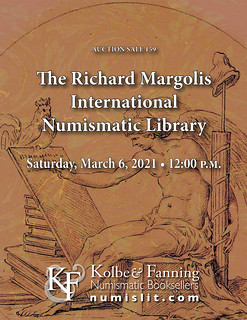 We are proud to have been given the opportunity to catalogue the Margolis Library and are delighted that the books were so well received by such a wide audience. It is our intention to prepare bound copies of the catalogue, in cloth and in leather, in the near future. We plan to conduct at least three more auctions in 2021, including the offering of a very important library of strong international appeal in the autumn. Details to come. In the meantime, we thank all of you who participated in the Margolis sale and invite anyone interested in keeping in touch with us to subscribe to our email list through
numislit.com.
We are proud to have been given the opportunity to catalogue the Margolis Library and are delighted that the books were so well received by such a wide audience. It is our intention to prepare bound copies of the catalogue, in cloth and in leather, in the near future. We plan to conduct at least three more auctions in 2021, including the offering of a very important library of strong international appeal in the autumn. Details to come. In the meantime, we thank all of you who participated in the Margolis sale and invite anyone interested in keeping in touch with us to subscribe to our email list through
numislit.com.
To read the earlier E-Sylum articles, see:
KOLBE & FANNING RICHARD MARGOLIS LIBRARY SALE
(https://www.coinbooks.org/v24/esylum_v24n06a02.html)
KOLBE & FANNING MARGOLIS LIBRARY HIGHLIGHTS
(https://www.coinbooks.org/v24/esylum_v24n07a02.html)
MORE KOLBE & FANNING MARGOLIS HIGHLIGHTS
(https://www.coinbooks.org/v24/esylum_v24n08a03.html)
KOLBE & FANNING MARGOLIS SALE CLOSES MARCH 6
(https://www.coinbooks.org/v24/esylum_v24n09a02.html)
NEW BOOK: UPPER SILESIA EMERGENCY MONEY
The Geldscheine Online site has an article on a new book about 1920s-era emergency money of Upper Silesia. Here's a Google-translated version. -Editor
Pieniadz Zastepczy na Górnym Slasku
w Okresie Plebiscytu i III Powstania Slaskiego
280 pages, fully illustrated in color, format 172 mm x 240 mm, weight 850 g, cardboard cover (hardcover) with thread stitching, Lublin 2020, ISBN 978-83-945629-4-6,
Collecting paper money is very common in Poland. In the past few years, numerous well-edited books on paper money have been published in our neighboring country. Among them also catalogs that deal with the emergency money of the former German eastern territories.
Price around 40.00 euros.
Wieslaw M. Pawlowski now presents a catalog whose title translates as Replacement money in Upper Silesia during the time of the plebiscite and the third Silesian uprising
and which should therefore also be of interest to many German collectors. Exactly one hundred years after the events in Upper Silesia, the author presents this catalog.
The emergency money issues of this era are not only listed, but almost completely illustrated in color, and there are also many notes on display that you would otherwise not see. In addition to the 50 Upper Silesian issuing offices, the author also deals with the donation receipts issued in the German Reich and the porcelain donation coins of the Provincial Committee of the Upper Silesian Province. The catalog concludes with notes from the Polish Plebiscite Committee in Bytom, the Central Plebiscite Committee in Warsaw and another issue from the Polish Plebiscite Committee for Upper Silesia.
Although the book was written in Polish, you do not need any knowledge of the Polish language or a dictionary to work with it. The issuers are arranged in alphabetical order and numbered according to the German place names. In addition, the current Polish place names are given. The issuer's individual stamps are then given a corresponding consecutive number. If known, details of the printer and the designing artist, format, watermark and variants are given. In 1922 and 1923, some of the emergency notes with the new value imprint were reissued in the then Polish part of Upper Silesia. In this case, the relevant basic license is given a note. The author has waived a valuation in zloty or euros, but rare notes are given the reference R - RRRR.
Reference information can be found for each voucher, e.g. B. on Ritter, Grabowski, Geiger, Tieste, to name only the most important. In contrast to the catalog by Rolf Ritter, "Notgeldscheine from the voting time 1920/22 in Upper Silesia", which was already before
40 years ago, Pawlowski was able to add a number of new issuers.
The good overall impression of the work is supported by the use of the high-quality paper and the excellent illustrations.
You can tell from the book that it was written with great attention to detail.
In the appendix, the German texts are translated into Polish and additional descriptions are made for the Polish users of the catalog. The catalog is recommended to every collector of Upper Silesian emergency money. With a print run of only 500 copies, the catalog is sure to be sold out quickly. It can be obtained directly from the author.
To read the complete article, see:
Katalog zum Ersatzgeld während der Volksabstimmung in Oberschlesien 1921
(https://www.geldscheine-online.com/post/katalog-zum-ersatzgeld-w%C3%A4hrend-der-volksabstimmung-in-oberschlesien-1921)
NEW BOOK: THAMES MUDLARKING
An article alerted me to a new book on Thames mudlarking, all about coins and other artefacts discovered by 'mudlarks' along the banks of the River Thames. A new museum could be in the works as well. -Editor
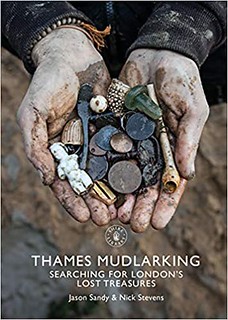 A beautifully illustrated book telling the captivating story of London and its inhabitants through the extraordinary assortment of artefacts discovered by mudlarks along the banks of the River Thames has recently been released – but could it be a precursor to an actual museum?
A beautifully illustrated book telling the captivating story of London and its inhabitants through the extraordinary assortment of artefacts discovered by mudlarks along the banks of the River Thames has recently been released – but could it be a precursor to an actual museum?
The answer is yes. Plans for the Thames Museum are currently in the concept phase only as the mudlarks are without a site.
In recent years the trustees of the proposed museum have exhibited in the Oxo Tower and the Tate Modern – and they are eager to find a home on the south bank of the River Thames.
Twice a day as the murky tidal waters of the river slowly recede, the exposed riverbed becomes the longest archaeological site in Britain.
This fact alone makes you wonder why a museum of this kind was not established years ago.
Unique, historically significant artefacts are continually being found in the river, and the Thames Museum will be a place for academics, visitors and school children to research and learn from these extraordinary finds. Currently they are being held in numerous places from the Museum of London to a single mudlark’s home or shed. And some of the most fascinating finds are rarely getting a showing.
Nick Stevens, who is also professional photographer and will be known to fans of the History Channel’s ‘Mud Men’ teamed up a with fellow member of the Society of Thames Mudlarks Jason Sandy to release their book ‘Thames Mudlarking: Searching for London’s Lost Treasures’ last month.
This fascinating new book is packed with 160 incredible photographs of intriguing objects discovered by over 50 mudlarks. Each offers a clue to the past and gives us a glimpse at London from megalodon teeth to Roman coins, Georgian shoe buckles and shrapnel from the Blitz.
To read the complete article, see:
A LONG READ: SEE THE LOST TREASURES OF THE THAMES IN A BOOK AND POSSIBLY A MUSEUM
(https://www.southwarknews.co.uk/history/a-long-read-see-the-lost-treasures-of-the-thames-in-a-book-and-possibly-a-museum/)
For more information, or to order, see:
Thames Mudlarking: Searching for London's Lost Treasures (Shire Library) Paperback - May 11, 2021
(https://www.amazon.com/Thames-Mudlarking-Searching-Londons-Treasures/dp/1784424323)
Thames Mudlarking: Searching for London's Lost Treasures (Shire Library) Paperback – 18 Feb. 2021
(https://www.amazon.co.uk/Thames-Mudlarking-Searching-Londons-Treasures/dp/1784424323)
NEW BOOK: EMPIRE OF SILVER
Numismatic research is closely linked to the study of economics. This new monetary history of China (reviewed in the Wall Street Journal) examines centuries of silver and paper money usage. -Editor
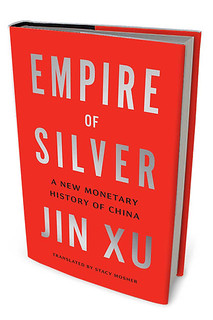 China may have been the first country to experiment with paper money, but modern finance took off in Europe rather than the Far East. In the West, banks and credit markets seeded the growth of capitalism. By contrast, China gave up on paper money long before Columbus set sail for the New World. From the 15th century through the 1930s, the Chinese were stuck with silver money. Without access to credit, the Middle Kingdom yielded economic primacy to England and later the United States. This important story is related in
China may have been the first country to experiment with paper money, but modern finance took off in Europe rather than the Far East. In the West, banks and credit markets seeded the growth of capitalism. By contrast, China gave up on paper money long before Columbus set sail for the New World. From the 15th century through the 1930s, the Chinese were stuck with silver money. Without access to credit, the Middle Kingdom yielded economic primacy to England and later the United States. This important story is related in Empire of Silver,
a quirky, though instructive, monetary history by Jin Xu, a Shanghai-based editor at the Financial Times Chinese.
Paper money, Ms. Xu tells us, dates back to the Tang dynasty in the ninth century, when the authorities allowed merchants to exchange bronze coins for promissory notes, known as flying cash.
Two centuries later, in the time of the Song dynasty, merchants in Sichuan were using private exchange notes in place of the cumbersome iron coinage. The Song emperor issued his own paper money against deposits of coin. The jiaozi, as these notes were called, proved so popular that they traded at a premium to cash.
The convenience of paper money proved its undoing, however. The first temptation was for the Song authorities to make the jiaozi inconvertible, severing the connection with metal reserves. The next step was to increase the issue of paper money, both to feed the people and, more pressingly, to fund the fight against the Mongol invaders. The inevitable outcome was inflation, followed by the collapse of the currency. The Mongols resurrected paper money. Marco Polo, in the late 13th century, reported that Kublai Khan, the great Mongol leader, had discovered the secret of alchemy
by making money from the bark of mulberry trees. But in time the Mongols issued too much paper and sparked a hyperinflation, as did their successors, the Ming. From the late 14th century onward, silver replaced paper money in China.
The advantage of white gold,
Ms. Xu emphasizes, was that it couldn’t be conjured up at the emperor’s command. The silver currency provided stability, a quality much prized by the mandarinate. But there were disadvantages. Lacking domestic reserves, silver had to be imported from abroad—first from Japan and then from the Americas. Massive inflows of silver promoted vigorous economic expansion in the late Ming era. In the 1630s, however, Spain stopped exporting American silver to the Far East. The money shortage in China that followed coincided with crop failures brought about by the Little Ice Age. Ms. Xu suggests that silver was the fuse
for the collapse of the Ming dynasty in 1644.
The Americans unwittingly brought silver’s long monetary reign to an end. In June 1934, President Roosevelt signed the Silver Purchase Act, instructing his Treasury to acquire the precious metal at several times its prevailing market price. Roosevelt intended to help out U.S. silver producers, but the chief effect of his measure was to suck silver out of China. Not long after, Chiang abandoned silver, issuing a paper currency that was printed in unlimited quantities after the Japanese invasion. The result was another Chinese hyperinflation. As Ms. Xu writes in her idiosyncratic fashion: History always knocks twice, first as comedy and then possibly as tragedy.
To read the complete article (subscription required), see:
‘Empire of Silver’ Review: Eastern Standard
(https://www.wsj.com/articles/empire-of-silver-review-eastern-standard-11615417784)
QDB: MY JOURNEY IN CONTINENTAL CURRENCY
This Whitman press release is an article penned by Dave Bowers about his interest in and experience with Continental Currency. -Editor
The Guide Book of Continental Currency and Coins, the latest Whitman Publishing book by Q. David Bowers, debuted this month (March 2021) and is already nearing a sellout, with a second print run planned. The 288-page book is volume 25 in the popular Bowers Series of numismatic references. It is available from bookstores and hobby shops and online (including at Whitman.com) for $19.95. Here, Bowers discusses his long-held interest in the money of the American Revolution.
My Journey in Continental Currency
by Q. David Bowers
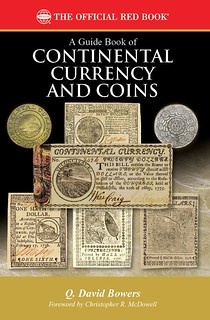 Continental money has fascinated me for a long time. My involvement in dealing in Continental Currency and Continental dollars in the 1950s led me to read many books on the history of the era, including J. Benson Lossing’s encyclopedic two-volume Field-Book of the American Revolution and the peripheral Timothy Dexter Revisited, by John P. Marquand, published in 1960. Soon after reading the latter, I went to Newburyport to visit the Dexter mansion on High Street and, courtesy of the owner, explored the beautiful building and grounds. The surrounding land was much smaller than depicted on engravings. At one time Dexter was one of the most interesting and enigmatic figures in town, with life-size statues of historical figures in the front yard (a few survive and have been restored). As I relate in my new Guide Book of Continental Currency and Coins, the source of Dexter’s fortune remains somewhat of a mystery, but it was most likely arrived at by speculation in federal and state Revolutionary War debt and Continental currency, the latter of which could be purchased for as low as $1,000 in paper for $1 in coins. He later redeemed it at a very profitable ratio after the federal government, under our current Constitution, instituted a redemption policy.
Continental money has fascinated me for a long time. My involvement in dealing in Continental Currency and Continental dollars in the 1950s led me to read many books on the history of the era, including J. Benson Lossing’s encyclopedic two-volume Field-Book of the American Revolution and the peripheral Timothy Dexter Revisited, by John P. Marquand, published in 1960. Soon after reading the latter, I went to Newburyport to visit the Dexter mansion on High Street and, courtesy of the owner, explored the beautiful building and grounds. The surrounding land was much smaller than depicted on engravings. At one time Dexter was one of the most interesting and enigmatic figures in town, with life-size statues of historical figures in the front yard (a few survive and have been restored). As I relate in my new Guide Book of Continental Currency and Coins, the source of Dexter’s fortune remains somewhat of a mystery, but it was most likely arrived at by speculation in federal and state Revolutionary War debt and Continental currency, the latter of which could be purchased for as low as $1,000 in paper for $1 in coins. He later redeemed it at a very profitable ratio after the federal government, under our current Constitution, instituted a redemption policy.
Along the way I formed a collection of bills by issue date and denomination, except for several that eluded me, including the 1775 $20 on French paper. I found the inscriptions and mottoes, which I first came across in the J.W. Scott Stamp & Coin Company Standard Catalogue No. 2, Paper Money, 1889, to be absolutely fascinating. The continuing research of Eric P. Newman, a fine friend from my teenage years onward, kept adding new information. A researcher par excellence, Newman’s works were factual rather than theoretical or guesswork, needing little later revision.
My experience with so-called Continental dollars has been extensive. Over the years I have bought and sold all of the die combinations. A favorite was the 1776 coin with the misspelling CURRENCEY corrected by the last two letters being recut and an ornament being added. Among these was the coin in the Emery May Norweb Collection that was sold to Eric Newman.
Eric was almost alone in his in-depth research into Continental dollars until 1991, when Michael Hodder’s The Continental Currency Coinage of 1776: A Trial Die and Metallic Emission Sequence
was published by the American Numismatic Association. This treated emission sequences, weights, and other data in a manner that had not been done before. At the time Michael was on the staff of Bowers and Merena Galleries in Wolfeboro, New Hampshire. In 1993 he, along with a small group of others, founded the Colonial Coin Collectors Club (C4), which grew to include today’s hundreds of members and to publish multiple reference books.
In the second decade of the present century the coins—or are they medals?—attracted a new wave of attention, especially as to where and how they were minted and distributed. Recent thought has been excellently synopsized in John M. Kleeberg’s study, The Continental Dollar; British Medals or American Coins?
published in the Journal of Early American Numismatics in December 2018. By then, other researchers including Bill Eckberg, Erik Goldstein, David McCarthy, and Maureen Levine had published other theories, mainly that the coins were in fact medals and had been made in Europe. Today, the debate continues. I present various ideas and detailed information in chapters 5 and 6 of my new Guide Book.
While I’ve always been fascinated by the Continental Currency bills and metallic pieces, their history has been an even greater attraction. The advent of the Internet has made it possible for me and others to do research with an ease that was not achievable earlier. No longer do I have to go to the American Antiquarian Society, the Library of Congress, and other institutions to fill out call slips and wait for a group of books to arrive. A few keystrokes make thousands of books, newspaper articles, and other sources available. In recent times I have gathered together my research notes dating back to the 1950s, arranged them in some semblance of order, and added much new information.
It is my hope that you will find the new Guide Book not only a useful companion to studying and perhaps collecting Continental Currency and dollars,
but also to enjoy reading about their history. I found the new (to me) information on the tyrannical restrictions that Congress placed on even discussing the depreciation of paper money to be especially remarkable. I think you, too, will learn much that is surprising, fascinating, and wondrous to consider.
A Guide Book of Continental Currency and Coins
By Q. David Bowers; foreword by Christopher R. McDowell; research associates Julia Casey and Ray Williams; valuations editor Bruce Hagen.
ISBN 0794848400
Softcover, 6 x 9 inches, 288 pages
Full color
Retail $19.95 U.S.
https://whitman.com/a-guide-book-of-continental-currency-and-coins/
To read the earlier E-Sylum articles, see:
NEW BOOK: GUIDE BOOK OF CONTINENTAL CURRENCY
(https://www.coinbooks.org/v24/esylum_v24n05a03.html)
REVIEW: GUIDE BOOK OF CONTINENTAL CURRENCY
(https://www.coinbooks.org/v24/esylum_v24n09a08.html)
ANA'S MANLEY NUMISMATIC LIBRARY REOPENS
The American Numismatic Association's Library has reopened for lending. Here's the announcement from the ANA's March 2021 Money Mail newsletter. -Editor
Lending and copying services from the ANA's Dwight N. Manley Numismatic Library will resume on a limited basis beginning March 18. (The library has been closed for COVID precautionary measures.) We ask patrons for their patience as turn-around times will be slower than usual while the ANA continues working with reduced on-site staffing.
Members can access the world's largest numismatic lending library and its more than 128,000 books, auction catalogs, periodicals and DVDs. The library features resources and materials including but not limited to coins, paper money, tokens, medals, military orders and decorations, and stocks and bonds. There are also volumes on collecting in general, economics, and banks and banking.
For more information or to borrow from the library, visit money.org/library or email library@money.org.
While more and more numismatic information is available online today, numismatic libraries remain as relevant and valuable as ever. A vast amount of information remains in-copyright and/or undigitized. A hardcopy book is often the only source of certain information, and physical books in hand remain generally easier and faster for reading and consulting.
Have a look in the online library catalog for your topics of interest. And if you're not already an ANA member, consider joining. -Editor
In his Coin Collector's Blog Scott Barman writes:
"A year after the pandemic shut everything down, the ANA Library is back! ANA members can check out books from the library and have them shipped.
"The ANA announced the library’s opening yesterday in their monthly Money Mail. After reading it, I found my notes with the four books I want to consult and submitted a request.
"The ANA Library might be the most underused benefit of being an ANA member. The library contains many hard-to-find and expensive books that might be useful for a short time. All you do is pay for the shipping in both directions, and the entire world of numismatics is delivered to your mailbox.
 "Books are an excellent resource for information that is no longer in the mainstream. For example, I developed an interest in foreign coins used as legal tender in the United States and the foreign coins struck by the U.S. Mint. There are a few resources, and they are challenging to find. None of the books are available in digital format.
"Books are an excellent resource for information that is no longer in the mainstream. For example, I developed an interest in foreign coins used as legal tender in the United States and the foreign coins struck by the U.S. Mint. There are a few resources, and they are challenging to find. None of the books are available in digital format.
"Having a ready library of references helps satisfy my curiosity. A few of the books have references to scanned books and articles found online at both the Newman Numismatic Portal and the Government Printing Office. These resources help in providing background to my reading.
"Having access to the digitized editions of the Numismatist also helps. ANA members can access the complete library of the Numismatist via their website or a smartphone app. It has been common to have the app open on my iPad while staring into the computer screen reading another resource."
To read the complete article, see:
ANA Library Opens Again
(http://coinsblog.ws/2021/03/ana-library-opens-again.html)
VIDEO: OLD GUYS TALKING ABOUT EARLY COPPER
These are selections from the David Lisot Video Library that feature news and personalities from the world of coin collecting. David has been attending coin conventions since 1972 and began videotaping in 1985. The Newman Numismatic Portal now lists all David’s videos on their website at:
https://nnp.wustl.edu/library/multimediadetail/522852
Here's one on early U.S. copper coinage. -Editor
Three Old Guys Talking About Early Copper
Video: 60:00.
 Moderator: Chuck Heck with Mark Borckardt, Denis Loring, & Darwin Palmer.
Moderator: Chuck Heck with Mark Borckardt, Denis Loring, & Darwin Palmer.
Hear these three longtime participants in the world of large cent collecting share their memories about collectors, deals, and dealers. The talk is candid, funny and enlightening. This presentation is a must for anyone who wants to know the esoteric stories of the early copper market.
The video is available for viewing on the Newman Numismatic Portal at:
https://nnp.wustl.edu/library/book/560155
PCGS NUMISMATIC WRITER OF THE YEAR AWARDS
PCGS has created a new award for numismatic writers. Congratulations to this year's recipients. Pictured is Jay Turner. -Editor
 Professional Coin Grading Service has launched a new writing award program to honor its top in-house writing staff, the very experts who help deliver the latest information from the grading desks and across the numismatic scene.
Professional Coin Grading Service has launched a new writing award program to honor its top in-house writing staff, the very experts who help deliver the latest information from the grading desks and across the numismatic scene.
The first individuals to be recognized as part of the inaugural initiative are PCGS World Coin Expert Jay Turner and PCGS Price Guide Editor Jaime Hernandez. Turner won the PCGS Numismatic Writer of the Year Award while Hernandez earns runner-up nods as PCGS Outstanding Writer.
We wanted to recognize the incredible efforts our writing team flexes each and every day in providing top-quality, well-researched educational and informational content to the numismatic world,
remarks PCGS President Brett Charville. Jay and Jaime are among a team of talented writers who each tirelessly share their numismatic knowledge and passion for their areas of the hobby with all dealers and hobbyists.
I can think of no better way to celebrate our writing team than to recognize two of our most prolific writers with these prestigious honors,
says PCGS Rare Coin Market Report Editor-in-Chief Joshua McMorrow-Hernandez. While much of the work Jay and Jaime – as well as our other phenomenal writers – produce is showcased in the PCGS Rare Coin Market Report and on the PCGS Blog, there’s a ton of work they proudly contribute that often goes unbylined in PCGS CoinFacts and throughout many other PCGS resources.
When I joined the grading team at PCGS in 2017, my goal wasn’t simply to be a grader, but to also contribute to PCGS and the numismatic hobby at large,
comments Turner, who has been a coin collector since the age of 13 and joined PCGS in 2017. In 2019, we sat in a meeting talking about what we as a company could do with the resources and knowledge at our disposal. Since then, PCGS has done many things toward this goal, including building a daily blog, social media promotions, and much more… It’s truly a team effort, and with the enthusiasm of the people at PCGS, the best is yet to come.
Two of Turner’s favorite articles include Hello Kitty and Her Coinage
(https://www.pcgs.com/news/hello-kitty-and-her-coinage) and The Guatemala 8 Reales Hoard Reassembled
(https://www.pcgs.com/news/guatemala-8-reales-hoard-reassembled).
There is also an article he wrote about the discovery of a rare 1776 Continental Dollar in a French junk box (https://www.pcgs.com/news/pcgs-paris-office-certifies-1776-continental-dollar) that was originally published in the January-February issue of PCGS Rare Coin Market Report; the story was later shared on the PCGS Blog, where it went viral on a variety of news media sites, including FOX News and Great Britain’s Daily Mail. Adds Turner, When I get the opportunity to share a wonderful coin or a piece I graded and has a great story, it’s a true thrill. It is pieces like (the 1776 Continental Dollar) that hopefully help expand numismatics and grow the hobby.
THE BOOK BAZARRE
CONTINENTAL DOLLAR OFFERED FOR SALE IN 1785
Julia Casey submitted these notes on an interesting discovery. Thanks! -Editor
Nuremberg Merchant in 1785
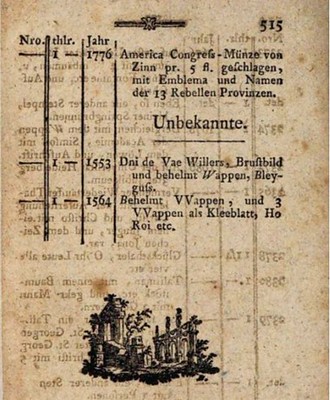 I had been researching the possible German origins of the Continental dollar coins/medals and came across this mention in Cathalog des von Seufferheldischen Münz - Cabinets so zu Nürnberg zu verkaufen steht , bei Muscat u . Seufferheld. I believe this firm in Nuremberg offered a pewter Continental dollar for sale in 1785.
I had been researching the possible German origins of the Continental dollar coins/medals and came across this mention in Cathalog des von Seufferheldischen Münz - Cabinets so zu Nürnberg zu verkaufen steht , bei Muscat u . Seufferheld. I believe this firm in Nuremberg offered a pewter Continental dollar for sale in 1785.
It is described as a thaler
of the date 1776 and further as: America Congress-Munze von Zinn pr. 5 fl. geschlagen, mit Emblema und Namen der 13 Rebellen Provinzen.
Perhaps someone can help with the translation? A basic application of Google Translate reads: America Congress-Coin struck from Tin pr.5 fl., with Emblems and Names of the 13 Rebel Provinces.
I am curious as to the significance of pr.5 fl.
?
Can anyone help with the translation? What do people make of this? If I'm interpreting earlier articles correctly, the first known recorded appearance of the coins was in German in late 1783. Julia's sale reference is dated 1785, and the undated Sarah Banks advertisement in English likely dates to that period or later. Of course, there's much, much more to the story than we can touch on here. -Editor
To read the complete catalog, see:
Cathalog des von Seufferheldischen Münz-Cabinets
(https://www.google.com/books/edition/Cathalog_des_von_Seufferheldischen_M
%C3%BCnz/rKZMAAAAcAAJ?hl=en)
To read some earlier E-Sylum articles (there are many more), see:
NOTES ON THE ORIGINS OF THE CONTINENTAL DOLLAR
(https://www.coinbooks.org/v20/esylum_v20n41a16.html)
CONTINENTAL DOLLARS REVISITED
(https://www.coinbooks.org/v21/esylum_v21n14a13.html)
WHAT'S NEXT FOR THE CONTINENTAL DOLLAR?
(https://www.coinbooks.org/v21/esylum_v21n29a10.html)
GOLDSTEIN AND MCCARTHY ON THE CONTINENTAL DOLLAR
(https://www.coinbooks.org/v21/esylum_v21n21a21.html)
1777 GERMAN ILLUSTRATIONS OF COLONIAL PAPER
Julia Casey also located some early mentions of U.S. colonial paper money in German publications. Thanks! -Editor
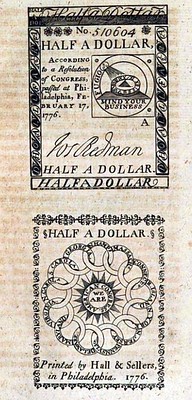 In addition to locating the 1785 catalog mention of the pewter Continental dollar my research also led me
to these two illustrations of Continental paper in 1777 German publications. The language is more
complex and I have not had much success translating these. Could someone assist?
In addition to locating the 1785 catalog mention of the pewter Continental dollar my research also led me
to these two illustrations of Continental paper in 1777 German publications. The language is more
complex and I have not had much success translating these. Could someone assist?
I found it interesting that the February 17, 1776 One Sixth of a Dollar is illustrated since that example has
the spelling of CURRENCY
as CURRENCEY
and this misspelling possibly carried through on some
of the Continental dollar coins.
Can anyone help with these translations? -Editor
To read the complete articles, see:
Neue europäische Zeitung
1777
(https://www.google.com/books/edition/Neue_europ%C3%A4ische_
Zeitung/L8RDAAAAcAAJ?hl=en&gbpv=1&dq=1776+dollar&pg=PP368&printsec=frontcover)
Deutsches Museum
(https://books.google.com/books?id=v3o3AAAAMAAJ&pg=PA189-IA2&dq
=dollar+%22mind+your+business%22&hl=en&newbks=1&newbks_redir=0&sa=X&ved=
2ahUKEwjfjNPGipjvAhUBU98KHacEDIQQ6AEwAHoECAEQAg#v=onepage&q&f=false)
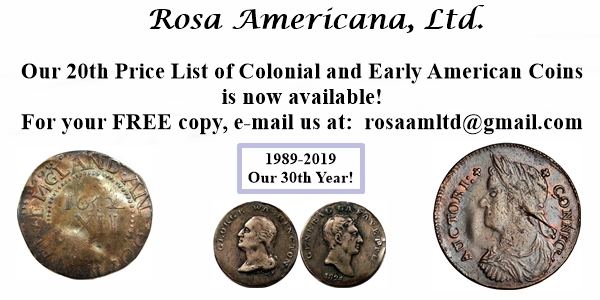
MORE ON COLUMBIA FARTHINGS
Martin Purdy writes:
"I remember discussing this subject with Jørgen Sømod around 20 years ago, and agree with his conclusion - they're almost certainly later examples of the kind of "evasion" coin that proliferated in Britain from the 1750s to the 1790s, though it seems no-one will ever know for sure. The question comes up every few years and I don't think anyone's improved on this explanation. The misspelling "Columbia" and the British style of manufacture pretty much rule out any connection with South America."
"It can now be concluded, that Columbia Farthings alone were manufactured in Britain and sent into circulation in England. The former dating, round 1830, is undoubtedly correct. The question is now: Why were they made? As an answer should be mentioned, that for years it was in Britain a tradition, that the major part of minor currency was private tokens of which many were without a name or issuer, why these token issuers just by issuing made their profit. An Act of Parliament declared them illegal in 1817, except for tokens of the Birmingham Workhouse and Sheffield Overseers of the Poor which were current until 1820 and 1823 respectively. The token issuers got then their business destroyed. By using the word COLUMBIA, it may be assumed the issuers tried to let people believe that their illegal tokens instead were money from an area in North- or Southamerica. Because many areas had the name Columbia, it would be difficult or rather impossible to discover the swindle"
Bob Leonard writes:
"While Sømod was correct that Neumann is the first European publication, in 1863, actually Neumann was preceded three years earlier by Montroville Dickeson in 1859.
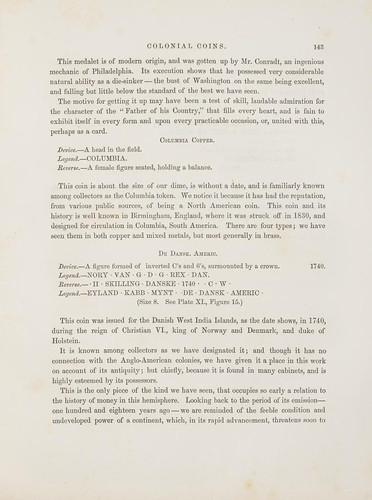 "Dickeson listed a Columbia farthing among U.S. Colonial coins, but only to refute that attribution. He supported the circa 1830 date, but repeated the error of attributing Columbia farthings to the nation of Colombia.
"Dickeson listed a Columbia farthing among U.S. Colonial coins, but only to refute that attribution. He supported the circa 1830 date, but repeated the error of attributing Columbia farthings to the nation of Colombia.
"These pieces are about the same diameter as an English farthing, but much thinner, giving a good profit to anyone successfully passing them off as farthings. In my opinion they fall into the same category as Frankfurt Jew Pfennigs, circa 1800-1823, and the Leiden MAXIMUS/NON PLUS ULTRA tokens of 1827. These are all similar farthing-size coppers on thin planchets, with meaningless inscriptions, intended to pass as genuine coins. They are a 19th-century version of farthing-size evasion coppers.
"I have a modest collection of Columbia farthing varieties, many purchased in England where I believe they were chiefly used."
Herman Blanton writes:
"The Columbia Farthing is interesting due to the mystery about them. I used to collect them but have since sold the collection. My interest is explained in the introduction to the article "‘COLUMBIA’ Farthings and Associated Pieces" by Paul Withers in Numismatic International Bulletin Sept/Oct 2013 available on the Newman Numismatic Portal."
"At one time I collected the so-called Columbia Farthings
and tried my best to figure them out. In my research of these enigmatic pieces I discovered that nobody else really knew what they were either. This year I pulled out my Columbia Farthings and set my mind to bringing closure [the end of my research] to this long unsettled arena within my collections even if it meant not learning of their origin.
"I reviewed my notes which include references to The Columbia Farthing
by Melvin Fuld (The Numismatist, May 1969 in the section The Token Collector’s Page
). Earlier articles in The Numismatist; The Columbia Farthings
by John F. Jones, August 1937 and Comments in the Mysterious Columbia Farthing-Size Token,
February 1948. I also found my correspondence with Granvyl Hulse (NI librarian at the time [1986]) concerning his article The Columbia ‘Farthing’
in the December 1985 edition of the NI bulletin.
"By using the internet I renewed my quest for information and it lead me to Paul Withers in England. Paul & Bente Withers provide a history of these tokens in their forthcoming book The Token Book 2 Unofficial Farthings and small Advertising Tokens, 1820-1901. With their kind permission we offer the Columbia Farthing section within these pages."
To read the Withers article in the NI Bulletin, see:
Numismatics International Bulletin
(https://archive.org/details/NIB2013SepOctVol48Nos09to10/page/n2/mode/1up)
Thanks, everyone. Looks like the Withers book is the go-to authority at this point. -Editor
To read the earlier E-Sylum article, see:
QUERY: COLUMBIA FARTHINGS
(https://www.coinbooks.org/v24/esylum_v24n11a15.html)
NOTES FROM E-SYLUM READERS: MARCH 21, 2021
American Tax Token Society 50th AnniversaryBill Myers writes:
"2021 is the 50th year of the American Tax Token Society. The Great Depression reduced the revenues the states received and in 1933 states started instituting a sales tax. The sales tax was up to 3% but put a burden on small purchases and every cent counted. The solution was to issue sales tax tokens in fractions of a cent (mills) to make the tax fair on small purchases. In 1971 the American Tax Token Society was founded by numismatists interested in the sales tax tokens. A stamped Missouri 1 mill tax token was given to members to commemorate the 50th anniversary. A newsletter is issued every quarter. Dues yearly dues are $8.50 for the electronic and $17 for the print newsletter. Dues can be paid via paypal at jnlcalvert@gmail.com or mail a check made out to Jim Calvert, 769 Bracken Ln, Nipomo, CA 93444"
Congratulations on the ATTS milestone! -Editor
Pete Smith writes:
"I was contacted by an antique collector who believes he has a portrait of Neziah Wright (1804-1879). Wright was a partner in Rawdon, Wright, Hatch and Edson. The firm produced the first U. S. Postage stamps in 1847. In 1858, seven companies merged to form the American Bank Note Company. Wright was then treasurer of ABNCo.
"The collector would like to find other portraits of Wright as a painting, engraving or photo. He would also like to know who previously owned the painting. Any contributions will be appreciated."
Can anyone help? -Editor
Tom Kays writes:
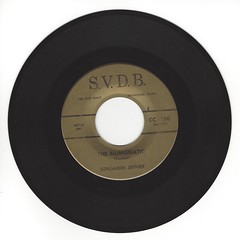 "About fifty years ago Alfred Hitchcock was featured on a Hi-Fi, 33-RPM, Long Playing, vinyl album with the A-side having a collection of spooky Halloween sound effects, like hissing black cats, things that go bump in the night, and haunted houses on the proverbial dark and stormy night. On the flip-side was an opus,
"About fifty years ago Alfred Hitchcock was featured on a Hi-Fi, 33-RPM, Long Playing, vinyl album with the A-side having a collection of spooky Halloween sound effects, like hissing black cats, things that go bump in the night, and haunted houses on the proverbial dark and stormy night. On the flip-side was an opus, Music to Get Murdered By
which painted a picture in sound, without words, of the creeping of a murderer, building up to a crescendo of screams and throat throttling. Those events were seen in one’s imagination, and so I remember it to this day, as a vivid ‘Hitchcockian’ drama.
"During the March Nummis Nova virtual dinner the discussion topic of Music to Collect Coins By
arose. Wayne Homren immediately noted that the Newman Numismatic Portal has archived some music about coins. I wonder if anyone knows of tunes that feature not just generic money, or simple coin denominations like nickels and dimes, but collectible numismatic items? Could we put together an eclectic playlist of Music to collect coins by.
Here are a few to get started:
- "Indian Head Penny by Guy Clark –
I rolled off the San Francisco Mint in 1909, the last one they ever made, you should’ve seen me shine….
-
So Much by Steve Warner –
...So I bide my time, spin my wheels like a mercury dime, It’s heads, it’s tails, plan C cannot fail...
-
St. James Infirmary Blues by Irving Mills -
...Put a twenty-dollar gold piece on my watch chain, so the boys’ll know I died standing pat...
Thanks, Tom. Song suggestions, anyone?
The two songs archived at the Newman Portal are the A and B sides of a 45 rpm record on the "S. V. D. B." label by Ben Jefmer. The songs are titled The Numismatic
and If You’re a Coin Collector.
Nummis Nova is my Northern Virginia numismatic social group. Usually we meet for dinner at a restaurant, but because of the pandemic we've been meeting on Zoom. Here's a screenshot of our March meeting, which took place this past Tuesday. Clockwise from top left are Tom Kays, myself, Jon Radel and Mike Packard. Bill Eckberg also joined us briefly, connecting from Florida. -Editor
To read the earlier E-Sylum articles, see:
COLLECTING NUMISMATIC AUDIO RECORDINGS
(https://www.coinbooks.org/esylum_v19n20a13.html)
NEWMAN PORTAL DIGITIZES VINTAGE 45’S
(https://www.coinbooks.org/esylum_v19n38a06.html)
NEW YORK WORLD'S FAIR MEDAL PROCESS SET
Skip Lane has a question about a process set of medals for the New York World's Fair. -Editor
I’ve been a subscriber to The E-Sylum for several years and find it very informative on a variety of numismatic subjects, not just literature. I have an inquiry that perhaps you can post as it seems that there are experts in all phases of numismatics among your subscribers. I recently acquired a process set
of medals for the 1964 - 1965 New York World's Fair by The Medallic Art Co. These were not presented to me as such, just part of a larger group of miscellaneous medals I purchased from a local coin dealer.
For my own amusement, I scanned each of the medals and made a composite image, front and back. There are eight pieces in the set, from blank planchet to finished medal with 6 stages of manufacture in between. They are not mounted; each is in its own Medallic Art Company box with cotton liners. Each box is rather crudely marked on top with black marker 1, 2, 3, 4, etc. I can't find any info on the medals on the internet. I did find a couple of similar sets for presidential inaugural medals but that's about it. I'm assuming as a set it is quite scarce.
My questions are: Were these issued for sale? Given to VIPs? Given to employees? Snuck out the back door? Might you have any idea as to the value? Any info would be greatly appreciated.
Great medals! The late Dick Johnson was our resident Medallic Art Co. expert. Can anyone help? -Editor
AMSA’S WOMEN’S SUFFRAGE MEDAL COMPETITION
The American Medallic Sculpture Association has announced the winner of their Women’s Suffrage Medal Competition. Here's the press release. -Editor
Eva-Maria Wohn Wins AMSA’s Women’s Suffrage Medal Competition
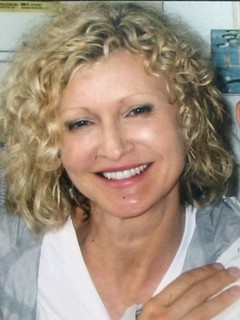 A relatively new medalist, Eva-Maria Wohn, of Chicago has created the best art medal on the theme of the 100th Anniversary of the 19th Amendment, granting women the right to vote. Sponsored by the American Medallic Sculpture Association (AMSA), the winner also will receive a $300 prize. Wohn’s medal was chosen by a committee chaired by Mel Wacks, member of AMSA’s Board of Directors, consisting of seven distinguished jurors: Philip Attwood, President of Fédération Internationale de la Médaille d'Art; Ellen Feingold, Curator of the National Numismatic Collection at the Smithsonian Institution; Cory Gillilland, formerly Deputy Director of the National Numismatic Collection; Caleb Noel, editor of The Numismatist; Steve Roach, editor-at-large of Coin World; Dr. Alan Stahl, Curator of Numismatics, Princeton University; and Dr. Benjamin Weiss, member of the Board of Directors of Medal Collectors of America.
A relatively new medalist, Eva-Maria Wohn, of Chicago has created the best art medal on the theme of the 100th Anniversary of the 19th Amendment, granting women the right to vote. Sponsored by the American Medallic Sculpture Association (AMSA), the winner also will receive a $300 prize. Wohn’s medal was chosen by a committee chaired by Mel Wacks, member of AMSA’s Board of Directors, consisting of seven distinguished jurors: Philip Attwood, President of Fédération Internationale de la Médaille d'Art; Ellen Feingold, Curator of the National Numismatic Collection at the Smithsonian Institution; Cory Gillilland, formerly Deputy Director of the National Numismatic Collection; Caleb Noel, editor of The Numismatist; Steve Roach, editor-at-large of Coin World; Dr. Alan Stahl, Curator of Numismatics, Princeton University; and Dr. Benjamin Weiss, member of the Board of Directors of Medal Collectors of America.
Eva-Maria Wohn wrote to the committee, saying: I had great fun coming up with a concept and a theme. The research alone was worth it. It’s such a beautiful art form I am always surprised that so few people have fallen under its spell. For the obverse side, I chose the Statue of Liberty to be part of a Suffrage medal, to point out the irony that she stood in the harbor for 34 years before she would have been able to vote in the very democracy she was symbolizing to the world. Liberty is not centered within the
100
because there is still some progress to be made. The reverse features a quote where we were but a handful
from Elizabeth Cady Stanton reminiscing about the few but radical supporters of the amendment, but also recognizing that so many lives would be changed because of it. The woman in jail is from an archive photo of a suffragette in prison.
Eva-Maria Wohn was introduced to the art of medals a few years ago by one of the modern masters of the medium, Eugene Daub. Since that time, she has created numerous medals in order to refine and explore various styles and to learn the technical aspects of sculpting medals. Wohn says that My attempts are not all aesthetic or technical successes, but each one has a lesson that informs the next piece and also my other sculptural work.
She believes that sculpting medals has given her tools that have made her bas relief, and sculpture in the round, infinitely better.
Wohn goes on: Because the geography of a medal is small, there is no room to hide bad composition, awkward perspective or poorly defined light and shadow. Being a good editor is just as vital as being a good sculptor.
Eva-Maria also loves the idea of a story compressed into such a small space. Her favorite medals are those that despite the limitation of space, invite the viewer to explore the message, saying: Overt messages are often less interesting than those that take the viewer on a journey to that end.
She tries hard to create a narrative that is interesting and engaging - one that leaves a viewer room to insert their own views and interpretations; one that invites wonder and curiosity, and ultimately, a kinship with the maker.
Eva-Maria Wohn will be the first to admit that her medallic sculptures have not always met that goal, but says that her love of this lovely art form makes the work of getting there a joy.
Wohn’s original submission was actually made with the cold-cast process. Since winning, she has decided to produce a limited edition of no more than 19 cast bronze 4-inch medals. For price and availability, contact Eva-Maria Wohn at ewohn@hotmail.com or (202) 341-3301.
All of the entries will be illustrated in AMSA’s full-color magazine Members Exchange. The American Medallic Sculpture Association invites American and world medalists to join, as well as art medal collectors. Members Exchange publishes news of workshops and exhibits, and illustrates noteworthy art medals produced by members and others both in the United States and overseas. Dues of $45, U.S. and Canada, or $55 elsewhere can be sent to AMSA, P.O. Box 1201, Edmonds, WA 98020. The AMSA website is www.amsamedals.org.
VOCABULARY TERM: DATES AND DATING
Here's another entry from Dick Johnson's Encyclopedia of Coin and Medal Terminology. -Editor
Dates and Dating. Indicating when a coin or medal was issued. The exact date is determined by both internal (appearing on the item itself) and external evidence (from documentary sources). Coins are usually required to be dated their year of issue. There is no such requirement that a medal must be dated; nor is there any obligation to use the year in which it is struck if it is dated. Most often medals bear the date of a historical or commemorative event, an anniversary or founding date, or the dates of a person portrayed on the medal.
In cataloging and attribution, determining the date often requires documentary research and, sometimes, stylistic comparison. The aim of the medal historian or numismatic researcher is to attribute the piece to a single year, or baring that, a period, a part of a century, or even a century itself. Often the evidence does not reveal as specific a point in time as the researcher or cataloger desires. The use of circa (Latin circum, around) is employed when the date of issue could be nearly ascribed a given year. An uncertain year is indicated by a question mark within parenthesis (?) following the date. When it is desirable to indicate a piece is not dated it can be abbreviated n.d.
Whenever possible numismatic researchers try to pinpoint an issue date to at least a particular quarter century (as: second quarter 17th century) if an exact date cannot be determined. Infrequently an academic year or a fiscal year is the issue date (as: 1892-93). And in rare instances an obverse can be one year, the reverse another (example: Louis XIII portrait of 1623 on obverse, Anne of Austria portrait of 1620 reverse). When all else fails and no date or century can be determined, a piece is simply attributed: undated. This should be a last resort, as any astute cataloger can at least attribute a piece to one of the five or six centuries medals have been issued or the twenty centuries for coins.
Internal evidence can take the form of (in order of preference if two or more appear): (1) year on the piece or date inscribed (called date of issue), if say an award or presentation medal; (2) date of anniversary year, if anniversary medal; (3) date accompanying artist's signature, if any; (4) date of copyright, if design is copyright or patented; (5) date given in inscription or chronogram, if present.
External evidence comes from any of a wide variety of documentary records, either from mint records (date given in a mint report), or medallic company (date pieces were cast or struck); or from the emitter (date first published, issued or founded), or date first offered for sale, or even from the artist's records when he completed his work.
As indicated, predating and postdating of medals do occur. A medal for the centennial of the American Museum of Natural History, for example, was designed three years prior, and struck two years ahead of its 1969 centennial year. Postdated is far more common. Extreme examples can be found among many Papal medals which were struck 100, 200 and 300 years after dates they portend to commemorate.
As also indicated, nothing would prevent an issuer from dating and publishing a medal at any time after an event he wishes to commemorate. An anniversary medal on a significant number of years after the event is understandable; but a medal issued at any other period is questionable. Such medals fall in the class of anachronistic medals – those struck in a period incongruent with the date on the medal (or other internal evidence). These medals elicit the astute cataloger's note: "This medal is obviously later than the date it bears." (See after-cast, reissue, restrike.)
The practice of dating by Roman numerals – mandatory for chronograms that work the date into the legend on inscription – has declined steadily. It was prevalent until the 20th century, however, has now fallen into disuse for dating medallic items.
Christian era. In Western civilization dates have been given in two calendars, the Julian and the Gregorian. Named after Pope Gregory XIII, the Gregorian calendar – devised in 1582 and adopted by four countries that year – is the one presently used. Not all nations accepted this calendar at the same time, and for awhile o.s. (old style Julian) and n.s. (new style Gregorian) calendars were used concurrently.
Eras. Medals have dates of various eras in countries for which they are used. Most notable, is the Mohammedan era with dates in AH, which began on July 16, 622 ad since the Arabic year is calculated on the lunar year of 354 days it is 3% shorter than the Christian year of 365 days. (To convert ah to ad subtract 3% of the ah date and add 621.)
Dating by reign. Some reigns, usually of brief duration, have been dated by the year of the reign. France did this after the Revolution. However in the instance of papal issues this has been the practice for centuries. The year of a Pope is numbered in Latin that appears on the medal (and some coins) as ANNO I, II and such. Once the correct Pope is identified it is easy to identify the year of issued by year of his reign.
Hallmark dating. Dating by hallmarks can lead to a specific year (and maker!) but the use of reference charts is necessary. Of the three or four hallmarks one will be the year mark. The shape and type style of the letter will indicate the year and this can be learned by reference to hallmark reference works. See hallmarks and hallmarking.
Masonic dating. An Arabic number above 5,000 appearing on a medal could indicate a date by Masonic dating. It is based on the assumption that the recorded world began 4000 bc. It is easy to determine the year by subtracting 4000 from this number to arrive at the Christian year.
Describing and cataloging dates. The date (or period) when made is one of the first things to identify and record when describing a coin or medal. This task is easy when the piece is dated, otherwise internal or external evidence must be used to ascertain the date (or era). Record exactly the form the date as given on the piece, in either Arabic or Roman numerals. All dates not given in Arabic numerals should be translated into Arabic. Occasionally when the design has divided a date (as for balance or spatial limitation) use the term date divided (omit a hyphen and record date exact).
References:
N8 {1969} Laing, Chapter 2, p 19-51.
To read the complete entry on the Newman Numismatic Portal, see:
Dates and Dating
(https://nnp.wustl.edu/library/dictionarydetail/515668)
ADOLF LARSON (1878-1967)
Here's another entry from the online draft of John Lupia's book of numismatic biographies. Thanks! This is an excerpt with the full article and bibliography available online. This week's subject is collector Adolf Larson, Jr. of Los Angeles, California. -Editor
Adolf Larson (1878-1967), was born on September 5, 1878 at Christiania, Norway, son of Adolf Larson (1851-), a carpenter, and Marie Albeck Larson (1844-). He came as a child with his family to Chicago, Illinois, in 1881.
He married a Swedish immigrant Jennie at Chicago and they had a daughter Leigh Maria, who became a university professor.
Pacific Coast Numismatic Society correspondence to Adolf Larson, Jr., postmarked March 21, 1921, San Francisco, California, postal stationery.
In the U. S. Census of 1930 he owned an artificial flower shop and his two younger sisters Dagmar (1881-), and Mable (1883-) lived with him and his wife and daughter.
In the U. S. Census of 1940 he still owned his artificial flower shop.
According to The Numismatist, March 1940, he was reported to be the newly elected president of the California Coin Club at Los Angeles. The Santa Ana Register, Tuesday, February 20, 1940, page 5, reported him coming as a guest speaker to the Orange County Coin Club meeting in February. The Numismatist, May 1940, reported that he was awarded honorary membership in the Orange County Coin Club.
He was a member of the Los Angeles Coin Club.
He died on March 9, 1967, and is buried in the Angeles Rosedale Cemetery, Los Angeles, California.
To read the complete article, see:
LARSON, Jr., ADOLF EMANUEL
(http://www.numismaticmall.com/numismaticmall-com/larson-jr-adolf)
ALAN STAHL EARNS GILES CONSTABLE AWARD
Princeton University Library numismatics curator Alan Stahl has won a new award - here's the announcement. Congratulations! -Editor
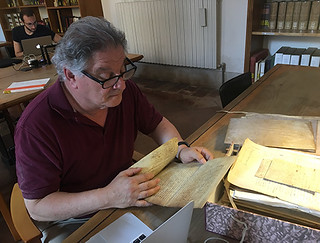 Alan Stahl, curator of numismatics at Princeton University Library (PUL), has been named the first recipient of the Giles Constable Award of the Gladys Krieble Delmas Foundation. The award, which is given to scholars advancing the study of Venice, was initiated in 2021 in memory of one of the longest-serving members of the Foundation’s advisory board, who passed away in January of this year.
Alan Stahl, curator of numismatics at Princeton University Library (PUL), has been named the first recipient of the Giles Constable Award of the Gladys Krieble Delmas Foundation. The award, which is given to scholars advancing the study of Venice, was initiated in 2021 in memory of one of the longest-serving members of the Foundation’s advisory board, who passed away in January of this year.
I am extremely honored to be the first recipient of a grant in the name of Giles Constable,
says Stahl. Not only for his work, which I respect enormously, but for the role he has played in the careers of generations of scholars with his broad range of interests and his unfailing personal encouragement.
Giles Constable was a historian whose work focused on the Middle Ages and the Byzantine Empire. After teaching at Harvard University and directing research at Dumbarton Oaks Research Library, Constable joined the faculty at the Institute for Advanced Study in Princeton. Best known for his religious and cultural histories of the 12th century, Constable helped shape popular understanding of Peter the Venerable, Byzantium, 12th-century reformation and crusading, and the monastery in Cluny.
The Delmas Foundation began supporting Venetian research efforts in 1977. In the four decades that followed, the foundation would support nearly 1,000 researchers with more than $4.5 million in awards and grants.
The Constable award includes a stipend, which Stahl intends to use to fund two months of archival research in Italy in 2022 on the topic of Commercial Organization in Late Fourteenth-Century Venice.
This project is a continuation of Stahl’s larger work on The Nexus of Wealth and Power in Late Medieval Venice,
which began in 2008 and continued with a fellowship from the Delmas Foundation in 2017-18.
Stahl joined Princeton University in 2004 and lectures in the departments of art & archaeology, classics, and history. In addition to teaching, Stahl is involved with developing Firestone Library’s Numismatic Collection, coordinating acquisitions like the recent purchase of 5,280 Byzantine coins from London-based numismatic scholar Peter Donald.
To read the complete article, see:
Curator of Numismatics Alan Stahl earns Giles Constable Award from Delmas Foundation
(https://library.princeton.edu/news/general/2021-03-03/curator-numismatics-alan-stahl-earns-giles-constable-award-delmas-foundation)
NUMISMATIC NEWS INTERVIEWS HOWARD DANIEL III
Tracy Schmidt of Numismatic News published a nice interview with Howard Daniel III. Here's an excerpt - see the complete article online. -Editor
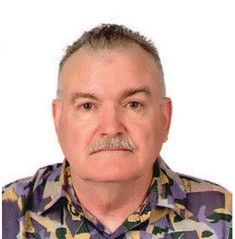 Q: What type of bank notes do you collect the most?
Q: What type of bank notes do you collect the most?
A: I first started collecting Viet Nam in 1964, then Cambodia, Laos, Thailand, Burma and the rest of Southeast Asia. But I held on to my old collection until 1973. Within a few years, my Vietnamese collection grew to have the largest number of bank notes and related pieces, and I am still adding more pieces to it.
Q: What is the most interesting bank note you have encountered?
A: There exists a 5 Dong note printed from 1949 by the Democratic Republic of Viet Nam to circulate in the Mekong Delta during the First Indochina War. This note is D-62 (Pick-17) in my Democratic Republic of Viet Nam Coins & Currency catalog. I always try to include the numbers of notes printed for each type and variety. There are two block letters, one serial prefix letter and six serial numbers on the most common variety. I could not break the format into the numbers printed until I had bought over 2000 of them in about a ten-year period! At the time of my research, I could buy them for Cents each but now they sell for Dollars each. Its block letters, serial prefix letters and serial number format was also used on some other notes so after I solved it for the D-62 note, it also gave me the numbers printed for the other notes.
Q: What is the most memorable or noteworthy acquisition in your collection?
A: My most memorable purchase is a unique survivor note from Phan Boi Chau, famous for his attacks against the French in 1921. The note was in a Hong Kong auction and incorrectly identified as a local Chinese note with an estimate of about US$50. I was going to bid US$1000 for it but I asked Joseph E. Boling for his advice about my bid. Joe told me to make it something less than US$100 otherwise they would pull it from the auction to find out its real value. I think I bid US$85 and got it. I was going to have a heart attack if I did not get it! It is a priceless and one of two unique survivors of Vietnamese paper money! There is only one other earlier unique survivor Vietnamese note from the same issuer in 1915 and it is owned by a Vietnamese living in Europe. Both are cataloged in my French Southeast Asia Coins & Currency catalog.
To read the complete article, see:
Collecting Southeast Asian Notes with Howard Daniel, III
(https://www.numismaticnews.net/paper-money/collecting-southeast-asian-notes-with-howard-daniel-iii)
HERITAGE OFFERS PARAMOUNT COLLECTION
This Heritage press release highlights several rare world coins in their upcoming sale of the Paramount Collection. -Editor
Paramount: the only word that comes close to describing the breadth, quality and rarity of this incredible collection that Heritage Auctions has the honor of presenting March 25-27. Comprised of 701 world and ancient coins, bidding is now open on the Paramount Collection World & Ancient Coins Signature Auction.
This is by far the most significant collection of world and ancient coins ever offered by Heritage, and it is likely the most significant collection to come on the market in at least a generation,
said Cristiano Bierrenbach, Executive Vice President of International Numismatics.
The Paramount Collection contains dozens of lots that are considered unique, with more than 100 multiple ducats that are 5 ducat size or larger, as well as coins that are making their first-ever appearance at auction.
This sale is stacked with world-coin rarities that, in some cases, haven’t been available at auction in decades, and in other cases, haven’t ever been offered publicly until now,
Bierrenbach said. In fact, there are coins in this collection that I’ve never even seen before.
VAST SELECTION OF WORLD COINS
The world coin section primarily focuses on large-format, gold coinage from Central and Western Europe, as well as the Americas. Many of these issues were struck to commemorate marriages and deaths, document the tumult of wars, mark the beginnings of revolutions and reformations, and one in particular, the abdication of a King instead of his coronation.
The Great Britain 1937 Edward VIII 5 Sovereign Pattern is one of only a small number of British Pattern coins produced for the would-be coronation of Edward VIII. The gold 5 Sovereign is the grandest and most prized of them all, and the Paramount specimen is the sole individual piece in private hands. Uncompromising in terms of its beauty and quality, this offering has achieved an incomparable PR67 Ultra Cameo grade by NGC, and it could very well be a $1 million coin,
Bierrenbach said.
Another highlight from this sale is a Saxony 10 Ducat of 1611 in Gem Mint State, as graded by NGC. If you look of the bust of Christian II, from the detail of his hair to the intricacies of his armor, it’s an absolute wonder that a coin over 400 years old has survived in such condition,
Bierrenbach said.
The extraordinarily rare France 8 Louis d’Or from 1640-A, graded MS61 by NGC, is a massive gold trophy coin from a series that includes the largest gold coins produced in pre-Republic France. Made specifically for use by the King, the reason for its existence was entirely symbolic: to demonstrate France’s wealth and opulence, a message reinforced by Jean Warin’s powerful portrait of Louis XIII.
IMPORTANT ROMAN MEDALLIONS
Though the ancients portion of the Paramount Collection is small in comparison, it’s holdings are still powerful. Led by a selection of Roman gold medallions, the first of which is a Maxentius (AD 307-312) AV quaternio or medallion of 4-aurei, struck circa AD 308 and graded MS 5/5 - 2/5, Fine Style, Smoothing, by NGC. This phenomenal medallion was issued as a commemorative during the restoration of the temple of Urbis Veneris, erected by Hadrian in AD 135.
A second Roman medallion, a Magnentius (AD 350-353) AV medallion of 3-solidi, has been certified by NGC as MS? 5/5 - 3/5, Fine Style, Light Graffito. It is larger than most ancient coins and presents exceptional artistry.
The Paramount Collection World & Ancient Coins Signature Auction is March 25-27 at Heritage Auctions. Two floor sessions are scheduled for March 25 and 26 with an internet session set for March 27. Learn more at HA.com/3096.
To read the complete press release, see:
Paramount Collection Presents World Coins Not Seen in Decades
(https://coins.ha.com/heritage-auctions-press-releases-and-news/paramount-collection-presents-world-coins-not-seen-in-decades.s?releaseId=4108)
NUMISMATIC NUGGETS: MARCH 21, 2021
Here's a selection of interesting or unusual items I came across in the marketplace this week. Tell us what you think of some of these. -Editor
Rudolf II. 1576-1612.
10 ducats n.d. Prague. Triple embossing. 34.56 g. Mint master Benedikt Huebmer. MAXI Û I Û CARO Û V Û ET FERD Û D Û G Û ROM Û CÆS Û REG Ú HISP Ü É The crowned and armored busts of Emperors Maximilian I, Charles V and Ferdinand I side by side r.//¥ HVNG Û BO Û DAL Û CRO zc Û ARCHID Û AVST Û DV Û BVRG double eagle, on the chest double coat of arms (Castile / Austria).
Dietiker 556; Fb. 14 d; Halacka 478 a.
GOLD. RR Pretty gold patina, tiny. Marginal flaws, very fine In his essay on the so-called triple eminence, the author Ivo Halacka considers this type to be very likely under Emperor Rudolf II.
A Google-translated lot description from the upcoming Künker sale. Nice coin - great triple portrait. -Editor
To read the complete lot description, see:
Rudolf II., 1576-1612. 10 Dukaten o. J., Prag. Dietiker 556; Fb. 14 d; H
(https://www.kuenker.de/en/auktionen/stueck/288899)
Northwest Company copper Holed Token 1820 AU58 Brown NGC, Br-925 (R5), FT-10B, Robins-29106. Engrailed edge (The Charlton Catalog designation of "reeded" for the edge is incorrect). Medal alignment. It is also one of the finest known examples, as the strike is superb, the surfaces iridescent, and no real evidence of corrosion. Perhaps exceeded in condition only by the John J. Ford unholed, plain edge token, sold in our auction of the Doug Robins Collection, Lot 29103. Extremely Rare. Sold with old collector envelope detailed provenance.
Great piece, holed as usual. From the Ford collection. Offered by Heritage in the Donald G. Partrick Collection. -Editor
To read the complete lot description, see:
Canada: Northwest Company copper Holed Token 1820 AU58 Brown NGC,...
(https://coins.ha.com/itm/canada/canada-northwest-company-copper-holed-token-1820-au58-brown-ngc-/a/61202-97064.s)
1876 U.S. Centennial Medal. Julian CM-11. Bronze, 57 mm.
Designed by William Barber. About 7,000 of these 57mm bronze medals were struck by the U.S. Mint. The reverse design of rising Liberty with unsheathed sword was one of the iconic pattern of the whole series, and therefore makes the relatively low mintage medal highly sought after. Offered with the original case as issued, which is probably much rarer than the medal itself.
This is an exceptionally well preserved, brilliant uncirculated specimen with lovely deep toning.
Found on the Brian Silliman Rare Coins website. The case is not pictured, unfortunately. -Editor
To read the complete lot description, see:
1876 UNITED STATES CENTENNIAL MEDAL, JULIAN CM-11
(http://www.bsrarecoins.com/1876-united-states-centennial-medal-julian-cm-11/)
COINS FOUND ALONGSIDE DEAD SEA SCROLL
Kavan Ratnatunga and Arthur Shippee passed along articles about the discovery of coins along with the ancient scroll that got a lot of press this week. -Editor
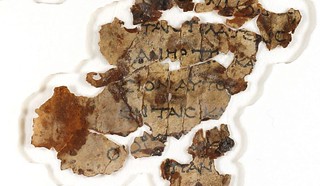 For the first time in 60 years, archaeologists have discovered a new fragment of the Dead Sea Scrolls, a cache of ancient Jewish and Hebrew religious manuscripts uncovered in the Qumran Caves on the northern shore of the Dead Sea.
For the first time in 60 years, archaeologists have discovered a new fragment of the Dead Sea Scrolls, a cache of ancient Jewish and Hebrew religious manuscripts uncovered in the Qumran Caves on the northern shore of the Dead Sea.
The Israel Antiquities Authority, which carried out the excavations, believes the new scroll, written in Greek, is actually a missing part of the Book of the 12 Minor Prophets
scroll, first discovered in 1961. It contains verses from Zechariah 8:16-17 and Nahum 1:5-6. The minor differences in the wording compared to other known manuscripts are important in helping shape our understanding of the evolution of the standardized Hebrew Bible.
The first Dead Sea Scroll was found by a Bedouin shepherd in 1947 in one of the most significant archaeological discoveries of the 20th century.
The new fragments were uncovered in the so-called Cave of Horror,
where archaeologists in the 1950s found skeletons of men, women, and children killed during the Bar Kokhba revolt, a Jewish rebellion against Rome circa 132 to 136, during the reign of Emperor Hadrian.
Evidence of Roman encampments on the cliff above the cave suggests that the rebels remained under siege until they died of starvation. The only way to access the cave is by rope, lowering down some 200 feet.
The new Dead Sea Scroll is among several recent archaeological finds, including a partially mummified 6,000-year-old skeleton of a child, Jewish coins from the time of the Bar Kokhba rebellion, ancient arrowheads, and a 10,500-year-old basket, kept intact—lid and all—over the millennia thanks to the desert’s hot, arid environment.
To read the complete articles, see:
In a Remarkable Find, Archaeologists Exploring the ‘Cave of Horror’ in Israel Have Discovered a New Dead Sea Scroll
(https://news.artnet.com/art-world/new-dead-sea-scroll-discovery-cave-horrors-1952209)
Rare ancient scroll found in Israel Cave of Horror
(https://www.bbc.com/news/world-middle-east-56405090)
MUGHAL-ERA GOLD COIN FIND IN INDIA
From Tribune Idia comes this story of a Mughal-era gold coin find near Pune. NOTE: the publication's image is NOT that of the find in question.
Found via The Explorator newsletter. To subscribe to Explorator, send a blank email message to: explorator+subscribe@groups.io. -Editor
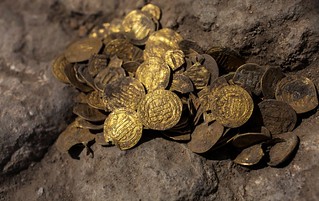 Over 200 Mughal-era gold coins, dating back to the early 18th century, have been seized from the possession of a family of construction workers in Pimpri Chinchwad near here, police said on Tuesday.
Over 200 Mughal-era gold coins, dating back to the early 18th century, have been seized from the possession of a family of construction workers in Pimpri Chinchwad near here, police said on Tuesday.
Some members of the family had found the coins while working at a construction site, said Pimpri Chinchwad Police Commissioner Krishna Prakash.
Inspector Shailesh Gaikwad of Crime Branch and his team had received information that one Saddam Salar Pathan was in possession of some gold coins.
"During a search of his house, 216 gold coins and one copper vase, weighing around 2.357 kg, were found," said Gaikwad.
"As per the preliminary assessment by the Archaeological Department, these are Mughal-era ‘mohurs’ (coins), dating back between 1720 and 1748 and issued by Emperor Muhammad Shah Rangila," he said.
Shah ruled from 1719 to 1748.
Saddam's father-in-law and brother-in law, who stay with him, were doing digging work at a construction site in Chikhali when they chanced upon some coins. They told Saddam and the trio returned to the site and found a broken copper vase containing more coins, said Gaikwad.
Saddam kept the coins at home. As per law, such discoveries have to be reported to the police and archaeological authorities.
To read the complete article, see:
Mughal era Gold coins found near Pune
(https://www.tribuneindia.com/news/nation/mughal-era-gold-coins-found-near-pune-222878)
NEW COIN: THE FIRST BRANDENBURG TALER
Today's dollar derives its name from the taler and Joachimstaler, the large silver coins of Europe. This article from the Künker auction house discusses Joachim I and an example of the first Brandenburg taler, estimated to sell for 50,000 Euros. -Editor
The coin offered as lot 2341 at Künker’s auction 348 is one of the great rarities of Brandenburg-Prussian numismatics: the first Brandenburg taler, minted in 1521. Of course, back then they weren’t called talers yet. Guldengroschen, as the correct term goes, are silver coins worth one gold gulden. Guldengroschen have actually existed since 1486, but the Joachimstaler
guldengroschen, which gave the taler its name, was minted for the first time only one year before the first Brandenburg taler.
Minting such new coins
– Moneta Nova is a common part of the inscription on early talers and can also be seen on our piece – was a question of prestige. For the production of talers was by no means profitable, at least it wasn’t in silver-poor Brandenburg – that’s why they stopped minting them as early as in 1522. The ruler who commissioned this coin was Elector Joachim I (1484-1535). The taler shows his bearded head-and-shoulder portrait. This was another novelty for the Margraviate of Brandenburg: it is the first Brandenburg coin featuring the portrait of an elector!
Elector Joachim I was a man of ambition. After the death of his father, he took over the rule at the age of only 15, initially together with his younger brother and under guardianship. He founded the University of Frankfurt an der Oder and fought robber barony in Brandenburg in order to strengthen his position with regard to the local nobility. Due to the eloquence, which he displayed in the assembly of the electors, Brandenburg-Prussian history gave him the epithet Nestor
as a reference to Agamemnon’s wise advisor. However, we should not read too much into it as it was a family tradition of early Hohenzollern rulers to have a classical epithet: the grand-father was called Achilles, the father Cicero and Joachim’s own son Hector – at least that’s helpful for coin collectors to remember whether the person was more distinguished by military success or their oratory skills.
Self-confidently, Joachim put his own portrait on the obverse of the first taler, as mentioned above, the first portrait on a Brandenburg coin. His clothing immediately alludes to the fact that he was one of the most powerful electors of the Holy Roman Empire: the elector’s cloak trimmed with ermine and the coronet identify him as one of the seven electors entitled to elect the emperor. In his hand he has a scepter, which can be seen once more on the coin, in the center of the coat of arms on the reverse. If you believe the scepter to be the random attribute of a ruler, you are wrong.
It is the imperial scepter of the emperor, one of the imperial insignia. As Arch-Chamberlain of the Holy Roman Empire, the Margrave of Brandenburg had always had the privilege of bearing the imperial scepter at the coronation of the emperor. This was a source of pride, even though no additional powers were associated with the office. That’s why the golden scepter on a blue background remained part of the Brandenburg coat of arms for centuries, depicted on the breast of the red heraldic eagle.
But let’s get back to our historical taler. It is extremely rare. Only a few specimens of these pieces were minted. Almost all of them were melted down in the following years due to their high silver content. Thus, only a few specimens of the first Brandenburg taler survived – just 23 pieces are known and almost all of them are kept in museums and large collections. Therefore, this auction provides the very rare opportunity to purchase a key piece of early Brandenburg-Prussian history.
To read the complete article, see:
Joachim I: The Power-Conscious Elector Who Minted the First Brandenburg Taler
(https://www.kuenker.de/en/information/presseinformationen/aktuelle-mitteilungen/352)
THE SILVER 1723 WOOD'S HIBERNIA FARTHINGS
Ron Guth has published a new blog post about the rarity of the Silver 1723 Wood's Hibernia Farthings. Great coins. -Editor
In 1722, William Wood obtained a patent to strike copper coins for Ireland over a fourteen year period. In actuality, Wood produced copper coins only from 1722 to 1724, at which time public resistance to the coins and a smear campaign by Jonathan Swift (author of Gulliver’s Travels) forced Wood to discontinue the operation.
In Wood’s three short years of production, he struck Farthings and Halfpennies for circulation as well as a few Pattern Farthings and Halfpennies in 1724. Numerous die varieties comprise the mintages of the regular-issue Farthings and Halfpennies.
Included among Wood’s Hibernia Farthings are some unusual silver pieces dated 1723. In the past, these silver versions have been called Pattern coins or prototypes, but their true nature is unknown. Syd Martin, in The Hibernia Coinage of William Wood (1720-1724),
listed three different Farthing varieties in silver: one of which was known only in silver; another that was an off-metal variant; and a third of indeterminate status Walter Breen, in his eponymous Complete Encyclopedia of U.S. and Colonial Coins,
listed two silver varieties as off-metal strikes with no reference to them being pattern coins.
Status aside, how rare are the Silver 1723 Hibernia Farthings? I’ve always thought of them as being very rare, since they appear at auction rather infrequently. Martin assigned a rating of Rarity 5 (or 46-75 known) to each of two of his varieties, which means he thought there were approximately 92 to 150 known. Breen called one of his varieties Very rare
and the other Ex. Rare
but gave no numerical clues. PCGS lists 36 examples in their PCGS Population Report, but that number may be inflated due to resubmissions. PCGS Auction Prices list 51 citations, but that number includes many duplicate appearances of the same coin.
By analyzing and examining historic auction records and catalogs, I have identified 32 demonstrably different Silver 1723 Hibernia Farthings and gathered photographs of each. Many of these coins came from well-known collectors such as Norweb, Ford, Partrick, Craige, and Eliasberg. Assuming there are several pieces out there
that were either missed or have not yet come on the market, I believe a fair estimate of the total number of Silver 1723 Hibernia Farthings to be on the order of 35 to 45 pieces.
Here’s what an analysis of the 32 examples in my database reveals. Twenty-seven examples are of the Martin 3.2-Bc.10 variety (Martin estimated 46-75 examples). Four examples are of the Martin 3.23-C.1 variety (Martin estimated 46-75 examples. Only one example is of the Martin 3.23-C.1 variety (Martin estimated 2-3 known).
To read the complete article, see:
How Rare Are The Silver 1723 Wood's Hibernia Farthings?
(https://numismaticdetectives.com/blog/f/how-rare-are-the-silver-1723-woods-hibernia-farthings)
1870 JAPAN WYON PATTERN SET OFFERED
This Stack's Bowers press release describes an interesting Japanese pattern set. -Editor
The April Hong Kong auction being presented by legendary rare coin firm Stack's Bowers and Ponterio features countless highlights from the Pinnacle Collection, with a majestic Year 3 (1870) Pattern Set from Japan standing as quite possibly the most impressive. Containing eight denominations ranging from the gold 10 Yen all the way down to the copper-nickel 1/20 Yen, the quality of the set is exemplified by each piece's Gem or Superb Gem designation as well as by the way the surfaces shimmer and glisten when rotated in the light.
This set's history can be traced to an exciting period of change within Japan following the opening of the island nation to the West and the closing of the feudal period much glamorized through tales of the noble samurai and stealthy ninja. The Meiji Emperor revolutionized the country's coinage system in 1869, replacing the old, ingot-and-plate-like denominations with more standardized, uniformly round decimal denominations. Prototypes were produced by Japan's master engraver, Natsuo Kano, in conjunction with Tomoo Masuda, who worked on design, and Hyoka Ishii, who focused on calligraphy. These designs were then sent to London where the nascent Japanese coinage could be taken to the next level.
Engraver Leonard Charles Wyon, from the famous Wyon family of engravers, prepared dies for the new coinage. These dies, along with their subsequently produced patterns, arrived in Osaka in the spring of 1870. Some modifications were made to the reverse design as well as denominations represented, with the 20 Yen being added and the 2-1/2 being reduced to 2 Yen for the initial output. By the end of the year, a new era of coinage began at the Osaka Mint.
While it remains unclear how many patterns were produced by Wyon in London, it is certain that the numbers are incredibly low, with just two complete sets remaining extant. One is believed to have remained with the British Royal Mint, now located in the Welsh countryside in Llantrisant, and other is the set offered here from the Pinnacle Collection. A handful of singles and strikings in other metals appear in the British Museum and Bank of Japan Collection; in private hands, the Yen turns up from time to time, but appearances are rare. The set offered in the Stack’s Bowers and Ponterio April Hong Kong Auction provides a unique bidding opportunity and may be impossible for any collector to duplicate. As such, it represents one of the most desirable—if not the most desirable—items in Japan's numismatic history, as not only is its rarity unsurpassed, but it is the patriarch of modern Japanese coinage and a symbol of the country's progress. A true national treasure, its April 2021 offering may well represent the last appearance for many generations to come.
For more information on the Stack’s Bowers and Ponterio April 2021 Hong Kong Auction or the Pinnacle Collection, visit the firm’s website at www.StacksBowers.com, call 800-458-4646, or email info@stacksbowers.com.
To read the complete lot description, see:
JAPAN. Pattern Set, Year 3 (1870). London (British Royal) Mint. Mutsuhito (Meiji). All PCGS Gold Shield Certified.
(https://auctions.stacksbowers.com/lots/view/3-QA5WL/japan-pattern-set-year-3-1870-london-british-royal-mintmutsuhito-meiji-all-pcgs-gold-shield-certified)
THE BOOK BAZARRE
A RARE 1860 CAMBODIA PIASTRE
This week's Featured Web Site is the Everycountry group, suggested by Andy Singer. Andy also passed along this example article by Paul Nichols, posted today, about a rare Cambodian coin. Thanks! -Editor
This week’s homepage coin is from the French Protectorate of Cambodia in Southeast Asia. Here is the very short version of how France gained control of the country. During the 17th and 18th centuries, the ancient Khmer Empire (Cambodia) came increasingly under the influence of its more powerful neighbors, Siam to the west and Annam (Vietnam) to the east. By the early 19th century, its national sovereignty had been lost, and Cambodia was placed under the joint suzerainty of Siam and Vietnam. During this time, the Cambodians continued to select kings who still had some authority over their internal affairs. King Ang Duong, who reigned from 1840 to 1860, tried unsuccessfully to forge an alliance with the French to help Cambodia regain more independence.
When Ang Duong died, his son Ang Voddey was chosen to succeed him, and he continued negotiations with the French. Ultimately, Ang Voddey, who took the name Norodom I, was literally forced at gunpoint to sign a treaty in 1863. That gave France control of Cambodia’s foreign relations in exchange for protection against its enemies, thus establishing the French Protectorate. Norodom could not be officially crowned king until 1864, after Siam finally released the Cambodian royal regalia (crown, sacred sword, and royal seal). As years went by, he became little more than a deputy to France, which gave him more time to spend with his own family. According to Wikipedia, he had 47 wives and 61 children, but no citation for those statistics is given. Norodom ruled with little power until his death in 1904, and the French retained control of Cambodia (from 1887 as part of French Indo China) until it became independent in 1953.
Several years after his coronation, Norodom issued a series of coins, all dated 1860. Most authorities believe they were struck in 1875, and Yeoman indicated the date 1860 on coins is the (incorrect) accession date.
Of course, if 1860 was meant to commemorate the year he was selected to be king, not the year of accession, it would be correct. Yeoman listed eight types – 5 and 10 centimes in bronze, and in silver, 25 and 50 centimes, 1, 2, and 4 francs, and the crown size piastre, issued as a presentation piece. The bronze coins were struck at the Heaton mint in England, the six smallest silver denominations in Belgium. Piastres were struck both in both Paris and Phnom Penh. KM originally assigned these coins regular catalog numbers, but decided several years ago they were all medallic issues,
and moved them to their Unusual World Coins catalog. It may be that some of the silver denominations did not circulate extensively, but that does not mean they were all medals. Dealer Scott Semans has pointed out that the bronze issues were clearly business strikes and belong in the regular catalog. My 10 centimes saw quite a bit of circulation and is not unusual at all.
The homepage coin, Jim’s piastre, is the one denomination that was definitely not meant to circulate. Back in 1966, Chicago’s Windy City Coin Company ran an ad in the Numismatist for a coin like Jim’s. It read: Truly a great rarity amongst the exotic type crowns of the world. This piece was designed by the great French sculptor Faconnet depicting the Royal Coat of Arms, and the denomination spelled out in five different languages in itself discloses the uniqueness of this specimen; only 200 struck for presentation.
The languages below the coat of arms are French and Spanish, but I am not sure about the languages above the arms. They look as if they could be Vietnamese, Khmer, and Thai; if not, you can let me know.
The designer’s name Faconnet appears below Norodom’s bust, and the Windy City ad is the only description of the coin I could find in which Faconnet was identified. Their identification, however, was wrong. The great French sculptor’s name was not Faconnet but Falconet, and he died in 1791 – 43 years before Norodom was born. I believe I may have discovered the actual designer, in Volume 2 of Forrer’s 5,227 page Biographical dictionary of medallists: coin, gem, and seal engravers, mint-masters, &c., ancient and modern, with references to their works B.C.500 - A.D.1900, published by Spink in eight volumes between 1902 and 1930.
The entry for Faconnet, Marie Anne Eugenie reads: Sculptor born at Paris; Pupil of J[ustin] Lequien, Jr. She is the author of a number of Portrait medallions in clay which are not without merit. One exhibited at the Paris Salon of 1870 is mentioned by Chavignerie.
Had Forrer or his source Chavignerie known that she designed the Cambodian piastre, he would have mentioned it. That short paragraph is certainly an underwhelming legacy for her, if in fact she is the Faconnet whose name is on this impressive coin. I doubt if many women were hired to design coins in those days. All the other denominations of the 1860 dated Cambodian coins were designed by the Belgian medallist Henri Charles Wurden, and the details of Norodom’s bust by the two designers is very similar.
Semans described three varieties of the piastre, and he added letters to the original KM number 49. Faconnet’s name on the variety he called KM-49a is more spread out and slightly curved, and on his KM-49b, it is straight and more tightly spaced. There were also restrikes struck many years later, which he designated KM-49r. Jim’s coin has the straight FACONNET, so his is variety 49b. In researching this coin, I found more than the usual amount of incorrect and conflicting online information, not only about who the designer was, but also about where the coins were minted, when they were minted, why they were minted, and how many were minted. If any of you have more definitive information, please let us know. Whatever the correct answers to these questions are, the fact is the 1860 Cambodian piastre is a very scarce coin indeed. Windy City was asking $950 for their choice proof example 55 years ago.
To read the complete article, see:
https://groups.io/g/Everycountry
ROYAL MINT ISSUES NEW BRITANNIA
David Sundman passed along this article from The Times about the Royal Mint's new profile of Britannia on limited edition silver and gold bullion coins. Thanks. -Editor
The Royal Mint has unveiled the first coin depicting Britannia as a woman of colour.
The limited edition coin is one of two new designs created by the artist PJ Lynch to offer a contemporary new vision of Britannia, reflecting the diversity of Britain today
.
Britannia, the national personification of Britain, first appeared on coins under the 2nd century Roman emperor Hadrian, when she was depicted carrying a spear and shield. The use of Britannia on coins was revived under King Charles II when her shield bore the crosses of St George and St Andrew and she carried an olive branch as well as a spear. Later modifications have included the replacement of her spear with a trident and the addition of a lion.
Last year the Royal Mint announced a commitment to ensuring greater diversity on British coins and unveiled a new 50 pence, with the phrase Diversity Built Britain
. Rishi Sunak, the chancellor, said that he requested the mint introduce the 50p to celebrate the We Too Built Britain
campaign, which works for fair representation of minorities’ contributions in all walks of life.
Mint officials said that the 2021 Britannia builds on its commitment, reflecting a nation which is diverse and evolving with a contemporary new depiction
.
Describing both the exclusive
design showing Britannia as a woman of colour, in profile, and a core
design, depicting a white Britannia with a lion, Lynch, said: Creating an original new design for an icon such as Britannia is a dream for an artist.
For the core range, I started with a lot of sketching — lots and lots of thumbnail drawings of Britannia herself in different poses, sometimes with her lion guardian, and sometimes with her trident and shield on a rocky shore with waves splashing at her feet.
Lynch added: For the exclusive editions in the range, I decided it would be a good idea to go in close for a profile portrait of Britannia.
Lynch, who is also a children’s book illustrator, added: I wanted her to look strong, resolute and attractive, but I also felt that her features should reflect something of the diversity of the people of Britain in the 21st century.
To read the complete article (subscription required), see:
All change for coin that reflects modern Britain from Royal Mint
(https://www.thetimes.co.uk/article/all-change-for-coin-that-reflects-modern-britain-from-royal-mint-5pdb2sznj)
SYDNEY HARBOUR BRIDGE TOKENS AND MEDALS
Regular readers know that my non-numismatic interests include the history of business, science and technology, and that includes great engineering achievements like the laying of the first transatlantic cable, and important bridges, tunnels, etc. This article on the Australian Coin Collecting blog is an interesting read about the building of the Sydney Harbour Bridge, illustrated with many commemorative numismatic items. Here's an excerpt, but be sure to see the complete article online. -Editor
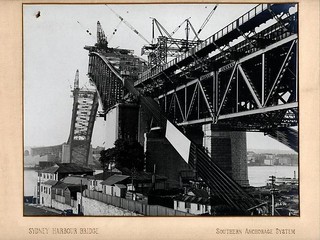 The bridge officially began construction on July 28th 1923 with the
The bridge officially began construction on July 28th 1923 with the turning of the first sod
at an official ceremony in Milson’s Point. This was 10 years after the Sydney Harbour Bridge project was first planned and over a hundred years after the first ideas were raised to build a bridge linking the Central Business District to the North Shore of Sydney. The government, through a tendering process worked through twenty proposals from six companies for the construction of the bridge awarding the contract to British firm Dorman Long and Co Ltd.
Calculations for the designs of the bridge filled 28 books and, in the end, it cost more than 10 million pounds to build the bridge (10,057,170 pounds, 7 shillings and 9 pence to be exact). This is just under a billion dollars in todays money.
The Sydney Harbour Bridge, affectionately known as The Coathanger
because of its arch-based design extends 1,149 metres from one side to the other. The arch spans 503 metres with four pylons standing 89 metres above sea level. Interestingly these four pylons serve no structural purpose and are a decorative feature only. It took 95,000 cubic metres of concrete and 17,000 cubic metres of granite stone to make the bridge. Steelwork weighing 52,800 tonnes is held together by around about 6 million rivets.
Here we have one of those rivets, or at least a slice of a rivet that was surplus to use in the bridge. These commemorative medals were struck on planchets made from slices of the excess steel rivets made by McPhersons P/L of Melbourne. It’s not known who was responsible for these but this example comes from the collection of a very good friend who saw my face light up when I saw he had one of these hard-to-find medals in such good condition.
Construction began from each side until meeting in the middle, this milestone reached 19th August 1930 just shy of 2 years after the arch construction began. In this afternoon the two halves met but celebrations were short-lived because expansion and contraction of the metal caused the bridge to separate again. They were rejoined later that evening. The tokens seen here were made at the time to commemorate the event and were sold at Noble Numismatics.
To read the complete article, see:
NSSA Presidents Numismatic Address -The Sydney Harbour Bridge
(https://www.australian-coins.com/coin-news/nssa-presidents-numismatic-address-the-sydney-harbour-bridge/)
YELLEN PROVIDES PAPER MONEY SIGNATURE
The new U.S. Treasury Secretary Janet Yellen provided her signature for the Bureau of Engraving and Printing. Look for it on a new banknote near you later this year. -Editor
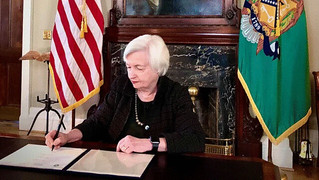 Treasury Secretary Janet Yellen last week provided her official signature that will be used on the 2021 series of U.S. paper currency, the department said Tuesday.
Treasury Secretary Janet Yellen last week provided her official signature that will be used on the 2021 series of U.S. paper currency, the department said Tuesday.
Treasury said Yellen provided her signature on March 10 during a meeting with Bureau of Engraving and Printing Director Leonard Olijar. The department plans to reveal her signature in the near future.
U.S. bills are signed by the Treasury secretary as well as the U.S. Treasurer.
New signatures may not be the only change to bills under the Biden administration. The White House said in January that it's looking at speeding up the process of putting Harriet Tubman's image on the $20 bill, after the Trump administration delayed the effort.
The signature of former President Trump's Treasury secretary, Steven Mnuchin, appeared on bills starting in 2017. Mnuchin and his wife, Louise Linton, toured the Bureau of Printing and Engraving in November 2017 to see the production of the first bills with his name.
To read the complete article, see:
Yellen provides signature for paper currency
(https://thehill.com/policy/finance/543434-yellen-provides-signature-for-paper-currency)
THE FACES ON WORLD BANKNOTES
Dick Hanscom passed along this National Geographic article about the faces on world banknotes. Here's an excerpt - see the complete article online. -Editor
Emblazoned with mottos, emblems, and historical imagery, money is one of the most tangible symbols of a nation’s identity. As that identity evolves, so too does the design of the country’s coins and banknotes—and the process can be fraught.
That has been the case in the United States with a plan to make abolitionist Harriet Tubman the face of the $20 bill, replacing former U.S. President Andrew Jackson. Although the U.S. Treasury had hoped to issue the design in time for the women’s suffrage centennial in 2020, the plan languished under President Donald Trump, who had criticized it as political correctness.
Now, however, the Biden administration has announced it will move forward with the redesign.
But how do countries determine whose portraits to feature on their currency, and what does it tell us about their pasts? Here’s a look at banknotes from around the world and the stories behind their creation—from the delicate negotiations to create a Bosnian currency in the wake of civil war, to the nations that have used their currency as a way to move on from colonialism and reckon with racist pasts.
Left: Many countries use their banknotes as a way to honor their earliest leaders. Seewoosagur Ramgoolam led the movement to end British colonial rule in Mauritius. In 1968, he became the country’s first prime minister and now appears on its 2000-rupee note.
Right: Celebrated as the father of the nation,
Michael Somare was a politician who led the push for Papua New Guinea’s 1975 independence from Australia. Somare, who now appears on the 50-kina note, was the country’s first and longest-serving prime minister.
To read the complete article, see:
What can the faces on its currency tell us about a country?
(https://www.nationalgeographic.com/history/article/what-can-faces-on-currency-tell-us-about-country)
BANKNOTE OF THE YEAR 2020 NOMINEES
Kavan Ratnatunga passed along this link to the YouTube channel for the International Bank Note Society's 2020 Banknote of the Year competition. There's a short video for each of the 24 nominated notes. Voting closed today, so we'll look forward to hearing the winner. -Editor
To watch the videos, see:
BNOY: Banknote of the Year 2020
(https://www.youtube.com/playlist?list=PLX2ZeuXKeuJVgGTgA5JaVp1-8xpW5KaH3)
COUNTERFEIT CURRENCY SEIZED IN BULGARIA
This Associated Press article describes a recent seizure of counterfeit currency in Bulgaria. See the photo gallery online. -Editor
Police seized high-quality forged banknotes produced at a printing office at a university in Bulgaria's capital, authorities said Tuesday.
In a joint operation with the U.S. Secret Service, Bulgarian police detained two people and seized a printing machine and equipment for printing money, along with large amounts of counterfeit U.S. dollar and euro notes.
The value of the seized currency is impressive. The material evidence speaks of serious criminal activity,
Sofia police chief Georgi Hadzhiev said Tuesday.
The amount of counterfeit money seized is $4 million and 3.6 million euros, according to the prosecutor’s office.
Police believe that the two suspects are part of a larger criminal enterprise, dealing in the trafficking of counterfeit dollars to Ukraine, and of euros to Western Europe.
To read the complete article, see:
Bulgaria, US seize millions of counterfeit dollars, euros
(https://finance.yahoo.com/news/bulgaria-us-secret-counterfeit-money-185644698.html)
LOOSE CHANGE: MARCH 21, 2021
Here are some additional items in the media this week that may be of interest. -Editor
Greg Reynolds published a series of three articles for the Greysheet about assembling a set of Connecticut Coppers. Here's an excerpt from the third installment. -Editor
In part one, of this series the background and meaning of Connecticut Coppers were discussed. In part two, the contents of a general set were explained. Although there are more than three hundred varieties of Connecticut Coppers, it is explained in part two that an affordable set of just twelve coins is complete in a logical sense, by date and subtype. Here in part three, the focus is on the costs and availability of the coins themselves so that collectors may commence building their respective sets.
1787 MUTTONHEAD, MAILED BUST RIGHT
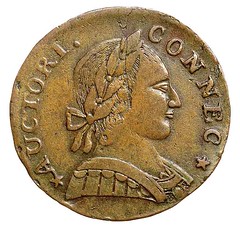 This has been termed
This has been termed Muttonhead
since before 1875. It is generally believed that these were not minted in Connecticut and not at the Machin’s Mills facility near Newburgh, New York. During the 18th century, there were informal, underground mints in North America, which often made imitations and counterfeits. A particular clandestine mint in Massachusetts is often cited by historians and Muttonhead Connecticut Coppers could very well have been made there.
It is possible that Muttonhead Connecticut Coppers were partly satirical in nature. Did they poke fun at King George III and Britannia? It is also possible that the differences in design were effected for legal reasons, to later argue, if necessary, that these were legal imitations of Connecticut Coppers rather than counterfeits minted with criminal intent. There were instances of clandestine mints during the 1780s intentionally making very inexact imitations with the intention of evading laws against counterfeiting or preparing a defense in advance. Although the pertinent legal issues during the 1780s were extremely ambiguous, the Muttonhead pieces are now regarded as true coins.
To read the complete articles, see:
CONNECTICUT COPPERS, PART 1: BACKGROUND AND MEANING
(https://www.greysheet.com/news/story/connecticut-coppers-part-1-background-and-meaning)
CONNECTICUT COPPERS, PART 2: Contents of a Logical & Affordable Set
(https://www.greysheet.com/news/story/connecticut-coppers-part-2-contents-of-a-logical-affordable-set)
CONNECTICUT COPPERS, PART 3: Easily Assembling A Set
(https://www.greysheet.com/news/story/connecticut-coppers-part-3-easily-assembling-a-set)
This article from Nashville is a nice view into the making of a new coin collector. -Editor
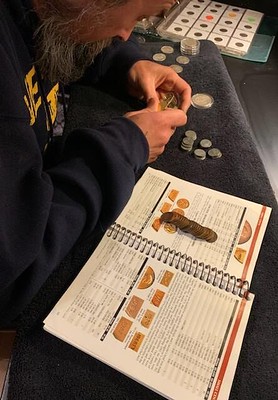
It started out as a hobby to get me through this past winter in off season,
said Hughes, who owns Hughes Lawn and Garden Solutions. I like to hunt for rare coins, tell their story and admit I love all the attention I get with my posts. Mostly, I love the history of an old coin and imagine where it’s been. I feel like it’s a win-win for everyone.
And, when you think about it, coin collecting is not like building a fleet of antique automobiles. Ironically, it’s a less monetarily demanding hobby, and whatever is invested in coins will at least return its original face value. When a streak of luck lands, the original investment is increased a 1,000-fold or more.
His side hobby started in today’s general way of exploration – through YouTube consumption.
I saw this guy buying silver bullion,
said Hughes.
He did a few searches and stumbled on J.M. Bullion, a U.S.-based online precious metal retailer. The bug gave him a little bite, and he went for broke and busted out $200 to buy three coins and a silver bar.
His side hobby started in today’s general way of exploration – through YouTube consumption.
I saw this guy buying silver bullion,
said Hughes.
He did a few searches and stumbled on J.M. Bullion, a U.S.-based online precious metal retailer. The bug gave him a little bite, and he went for broke and busted out $200 to buy three coins and a silver bar.
To read the complete article, see:
Coin Collecting Connoisseur
(https://www.mainstreet-nashville.com/communities/coin-collecting-connoisseur/article_33798cf2-84fd-11eb-b715-d7ffd9f1a0ea.html)
YOUNG FOLKS DISCOVERING ANTIQUES
For some time the narrative around antiques and collectibles has been that younger generations aren't interested and collecting is going the way of the dodo bird. But this Los Angeles Times article notes a trend in the opposite direction - young folks discovering antiques through social media. -Editor
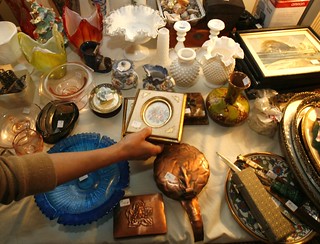
Sup, queens,
Macy Eleni calls to her quarter-million TikTok followers in a recent video. Welcome to another ultra-fabulous, packed-to-the-brim Los Angeles estate sale.
Since the start of the pandemic, Eleni has racked up a rabid following as she shops her way through estate sales, thrift shops and antique stores, dropping tips for newbies to the pre-owned world she has haunted since she was a kid. The twist: Eleni is 28 and her followers skew even younger than her fellow millennials.
This runs counter to all that the kids don’t want your stuff
downsizing advice doled out in recent years by AARP and others. PBS’ long-running Antiques Roadshow
regularly updates vintage episodes showing sharply lower appraisal values, particularly for furniture.
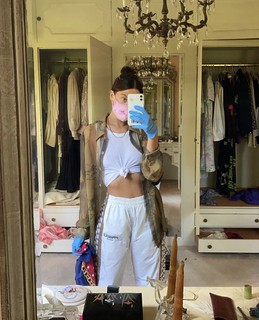 But COVID has changed everything. Stuck at home and videoconferencing, young people with eco-conscious values have become a prized new market for antiques and art to liven up their spaces, moving up the shopping ladder from de rigueur vintage clothing, anecdotal evidence indicates.
But COVID has changed everything. Stuck at home and videoconferencing, young people with eco-conscious values have become a prized new market for antiques and art to liven up their spaces, moving up the shopping ladder from de rigueur vintage clothing, anecdotal evidence indicates.
Eleni realized she had tapped a rich vein when she was switching apartments during the first week of the coronavirus lockdown, and, with thrift stores closed down, she visited an estate sale to scope out things for her new place. The house was a 1980s mansion, and she decided to film the trip and turn it into a TikTok, where she is known as @blazedandglazed.
By the end of the day, her post had tens of thousands of views with a comments section full of teenagers who’d never heard of such an event, where people open their homes with an everything must go
mentality. Usually, it’s because someone has died and the relatives want to sell their possessions quickly, or a homeowner is moving and can’t take everything with them.
Eleni never spends more than $100 per item, and her hauls have included antique jewelry, clothing, furniture and home décor. Standouts include a pair of custom trash cans: a leopard-print one and a ribbed-glass one she describes as sexy ‘80s dad vibes.
Her rapid success has landed her partnerships with multiple companies that run estate sales. Often, she’ll go in a day early and film a video to promote the sale.
TikTok blows everything up,
said Eleni, who graduated from Ohio University with a retail and fashion degree and hopes to eventually parlay the viral fame into a thrifting TV show. Posting one video can change a thrift store’s life.
Stefani Colvin, a 21-year-old musician and estate sale frequenter, has another theory on the uptick in younger antique enthusiasts.

Young people aspire to be different, especially Gen Z,
she said. The idea of having something old no one has is appealing to us.
During the pandemic, Colvin has been making money through Depop, a secondhand sales platform primarily used by Millennials and Gen Z. To date, she’s sold 1,541 items and racked up 30,000 followers for her unique offerings including Betty Boop tank tops, colorful sweaters and shirts with flaming skulls.
To read the complete article, see:
In the pandemic, young folks discover antiques for Zoom and nostalgia
(https://www.latimes.com/business/story/2021-03-14/pandemic-antiques-young-buyers)
FEATURED WEB SITE: EVERYCOUNTRY
This week's Featured Web Site is the Everycountry group on groups.io, suggested by Andy Singer.
The Everycountry group is a forum for world coin collectors who collect one coin per country or per coin issuing authority, A to Z. Members discuss and research coins from different countries, especially unusual or hard-to-find locations. Of particular interest are countries such as Germany, Italy, China, India, Switzerland, and Mexico, which have seen countless coin-issuing authorities over the past several centuries. Our 6,800-line checklist can be downloaded by members and then edited to conform to their own collections. In addition to current countries, the checklist includes state and local coinage, siege and other emergency coins, and rebel issues for the past several hundred years. New group members are always welcome, whether you are an A to Z collector or have a general interest in world coins. The homepage coin is from Cambodia.
Andy writes:
"Paul Nichols, a stalwart early member who recruited me years ago, has been writing a weekly article for the homepage using the A to Z format that the group generally puts to good use. Paul’s articles are especially well written and quite detailed. Today’s is particularly interesting."


